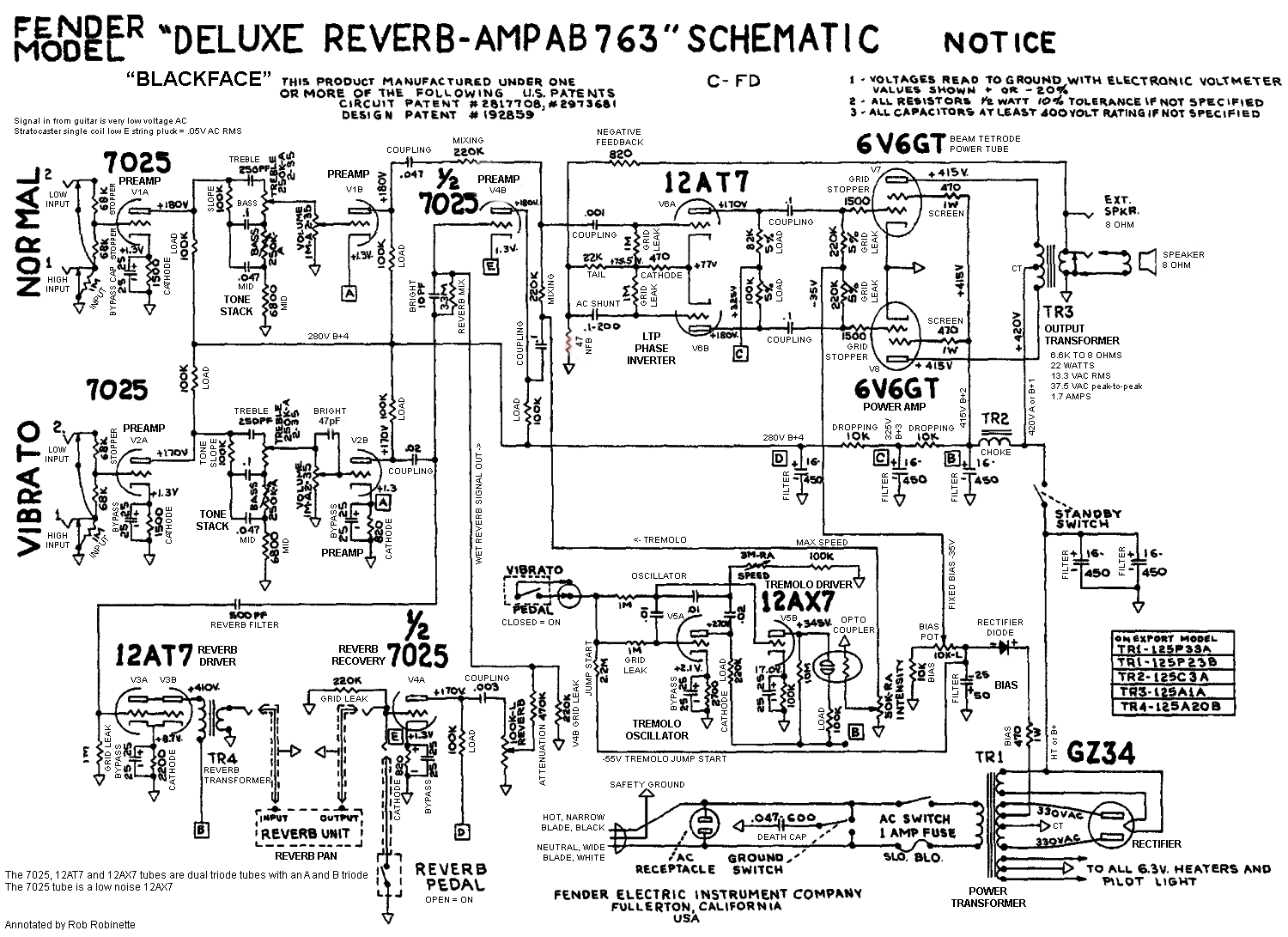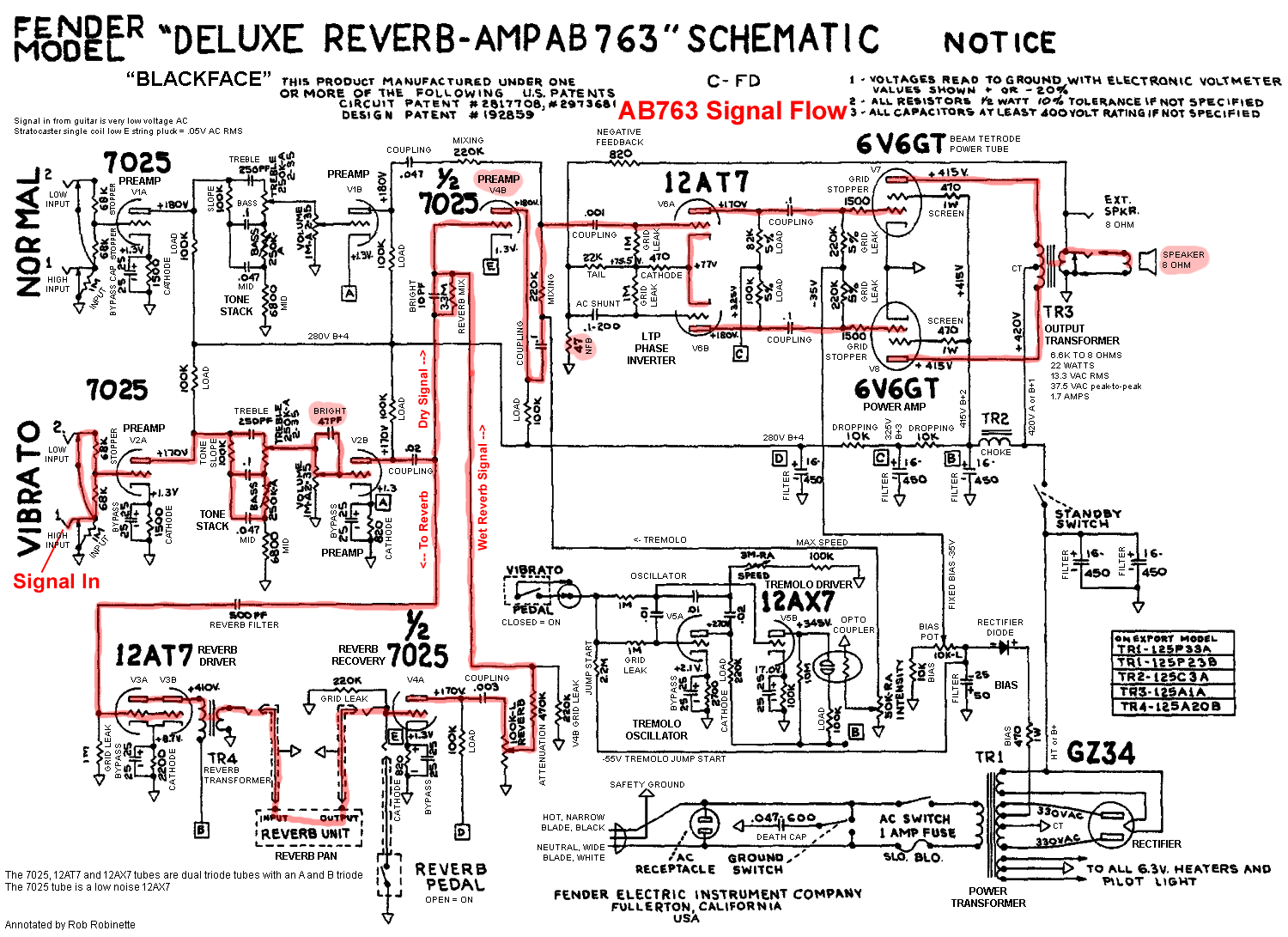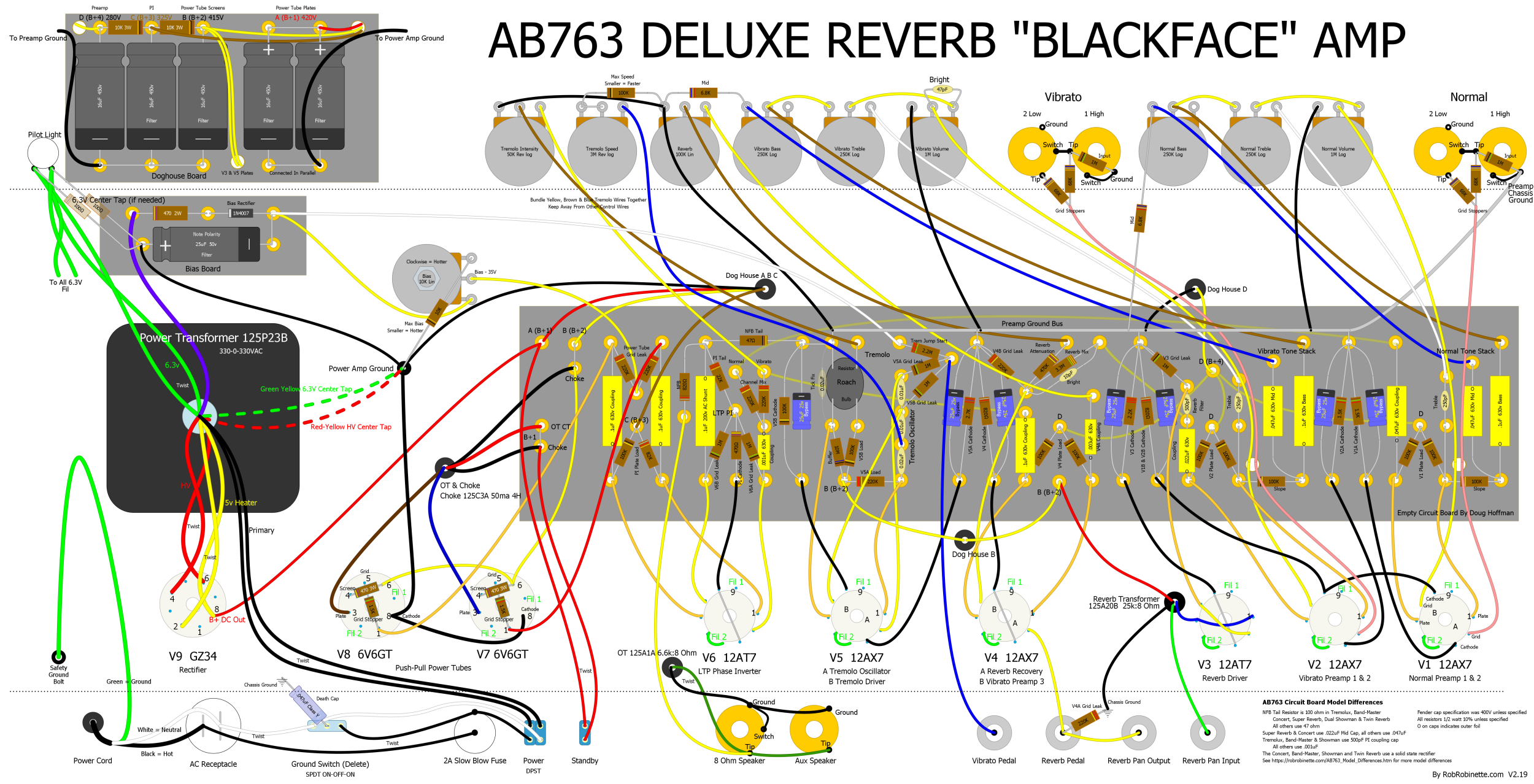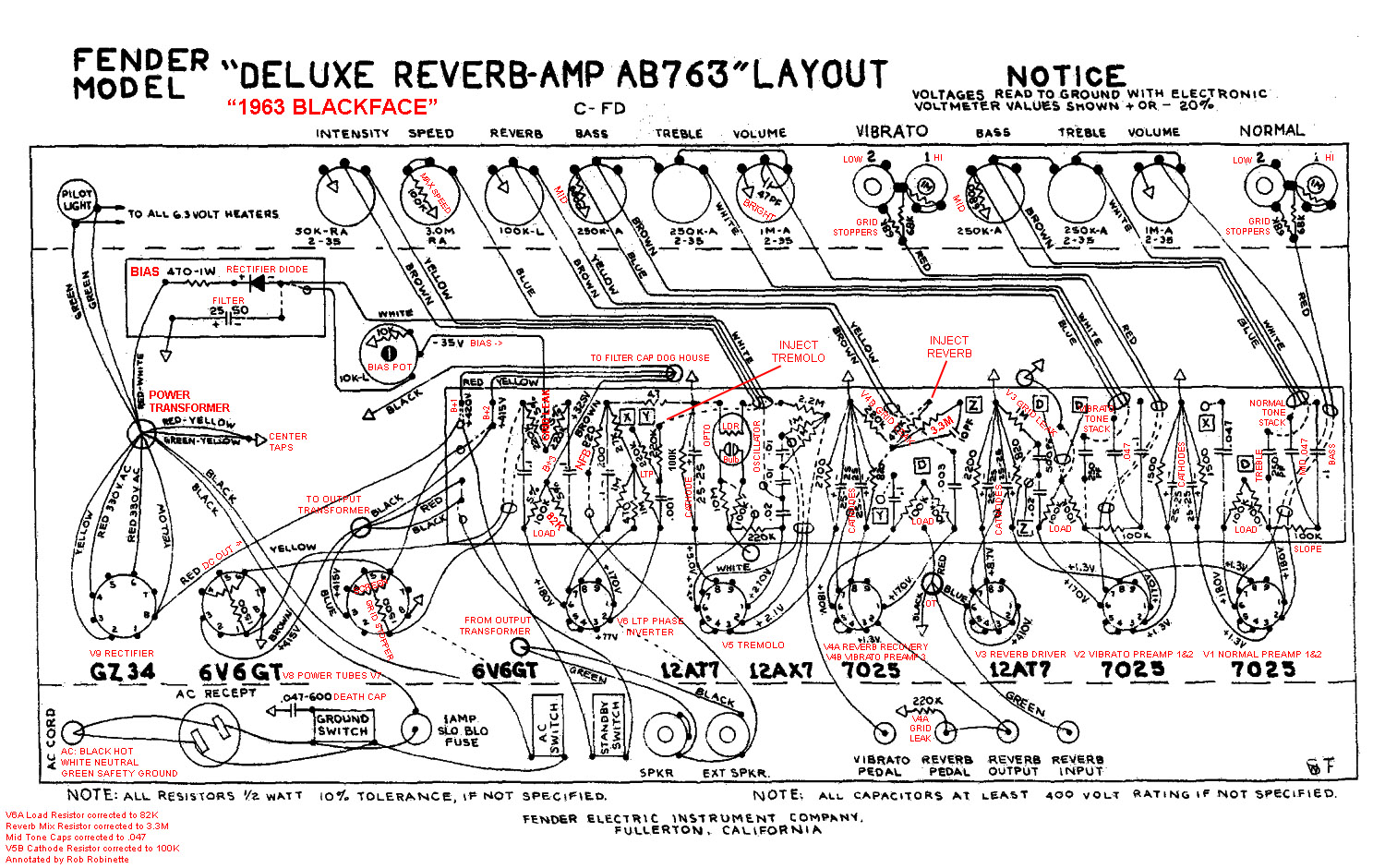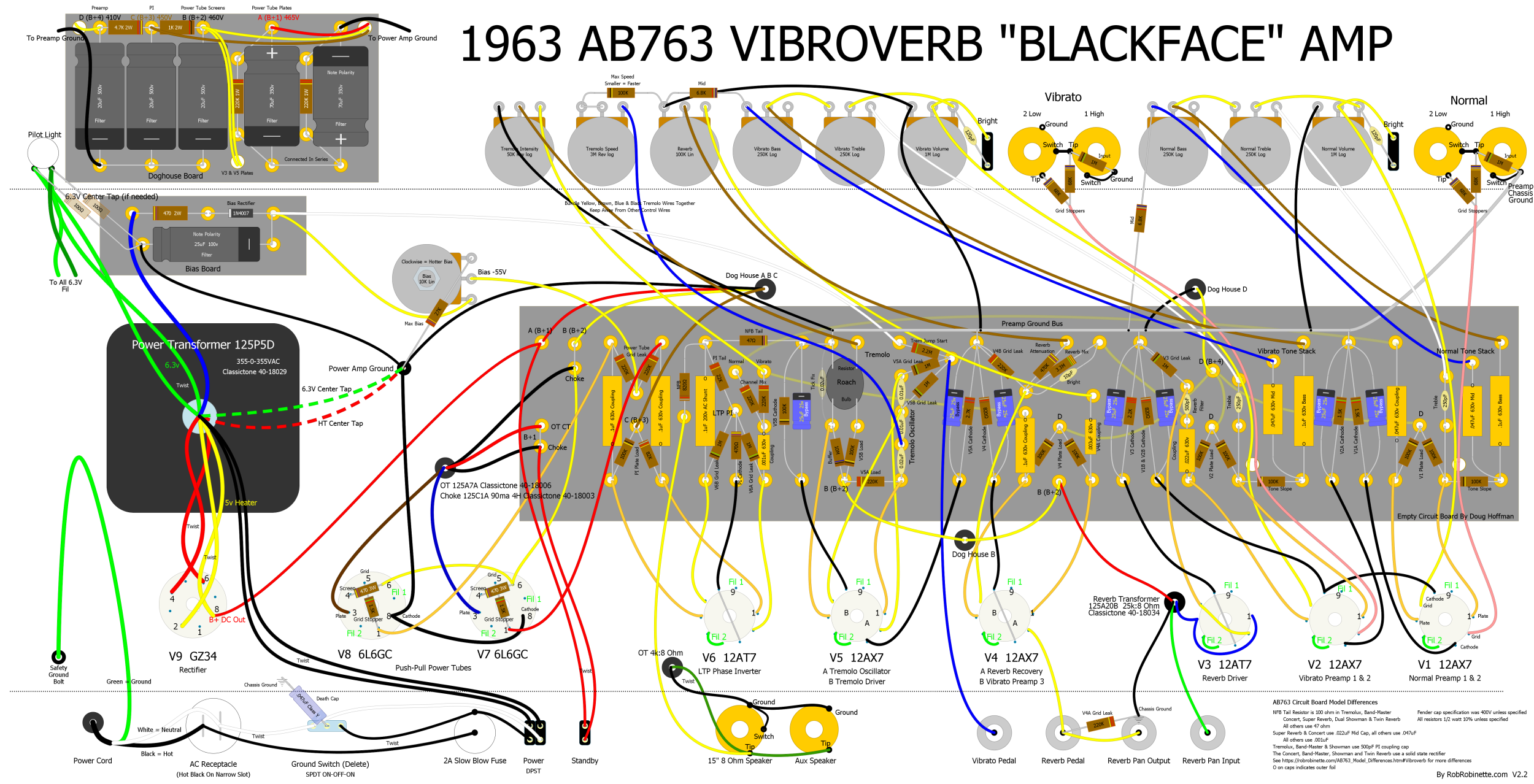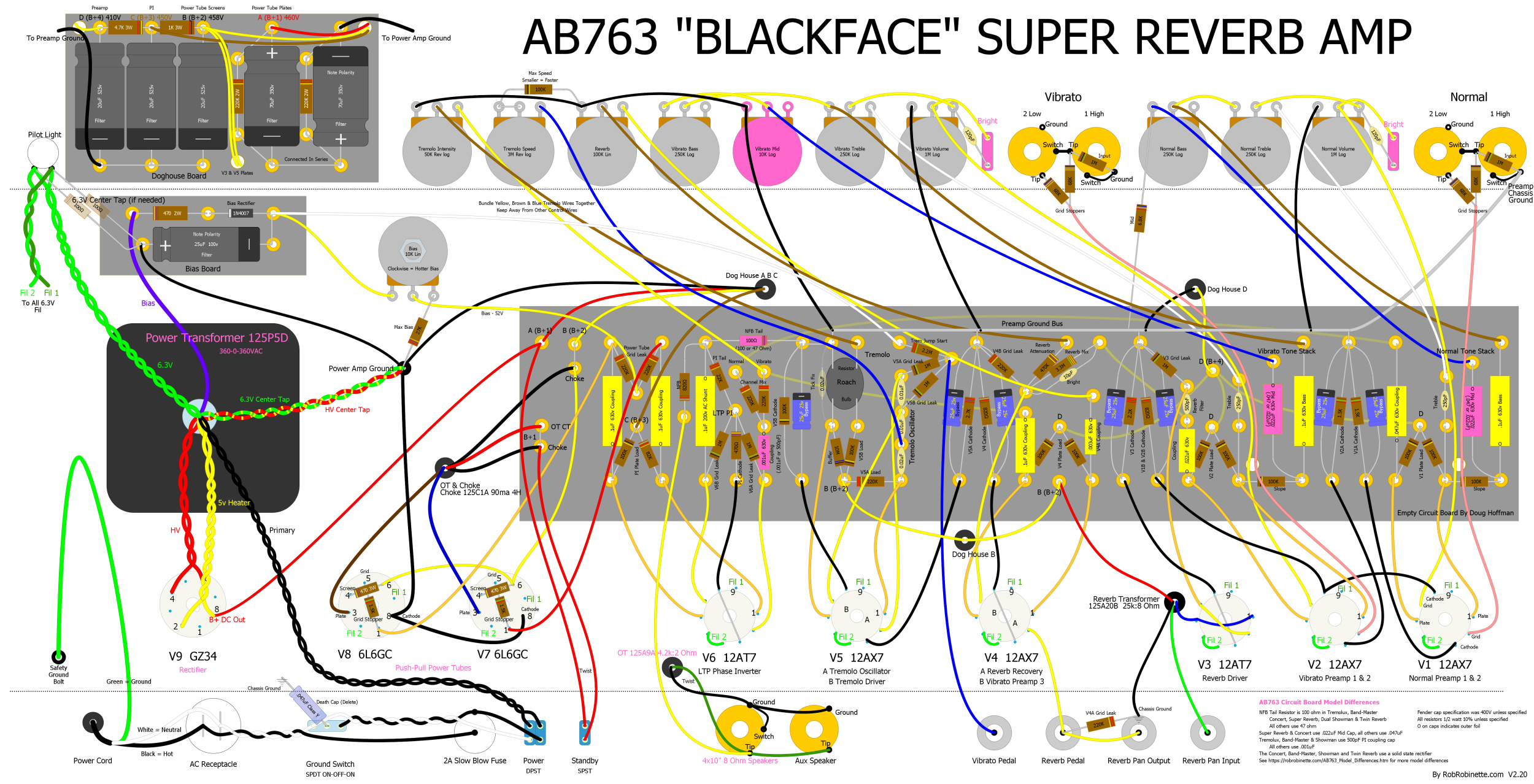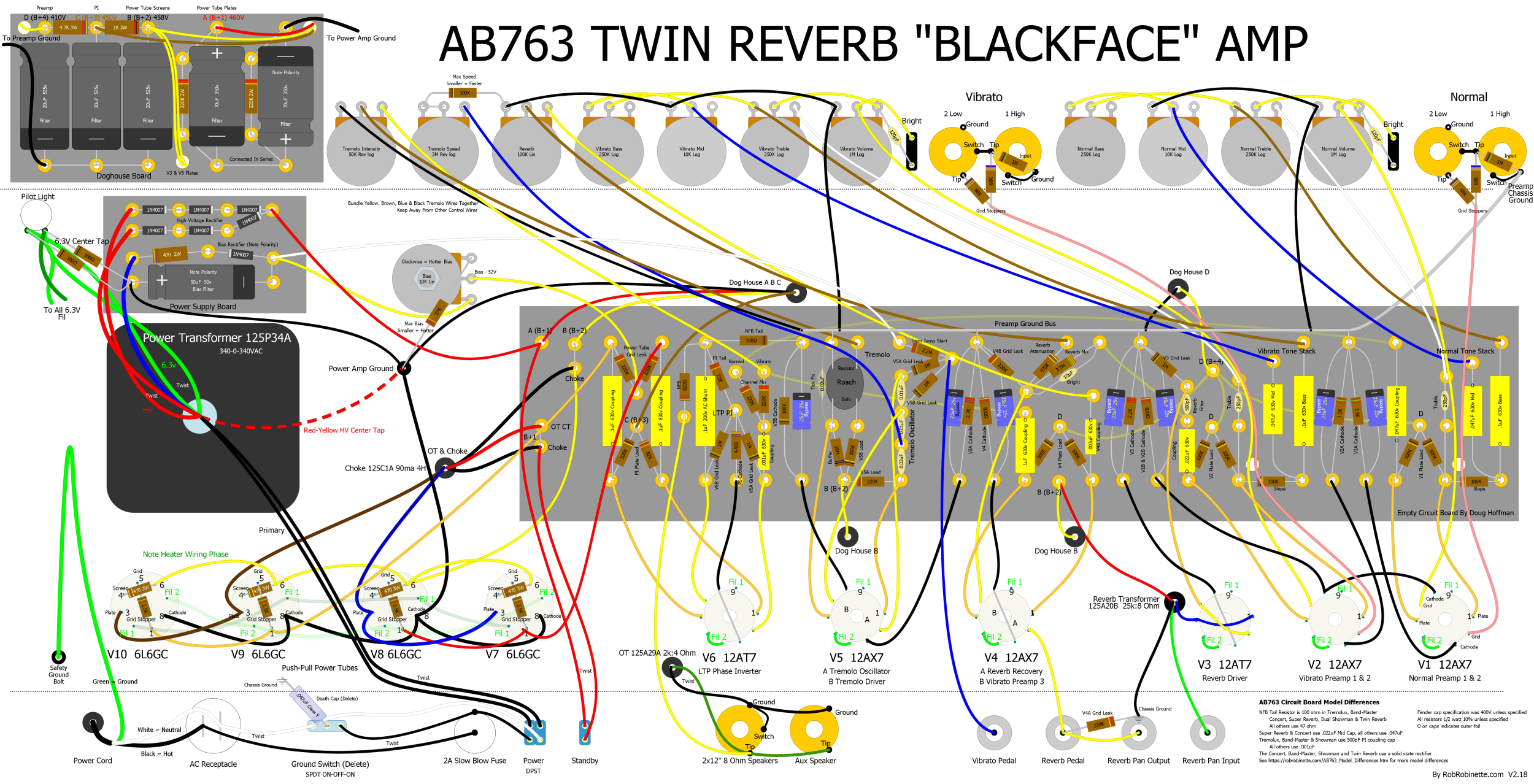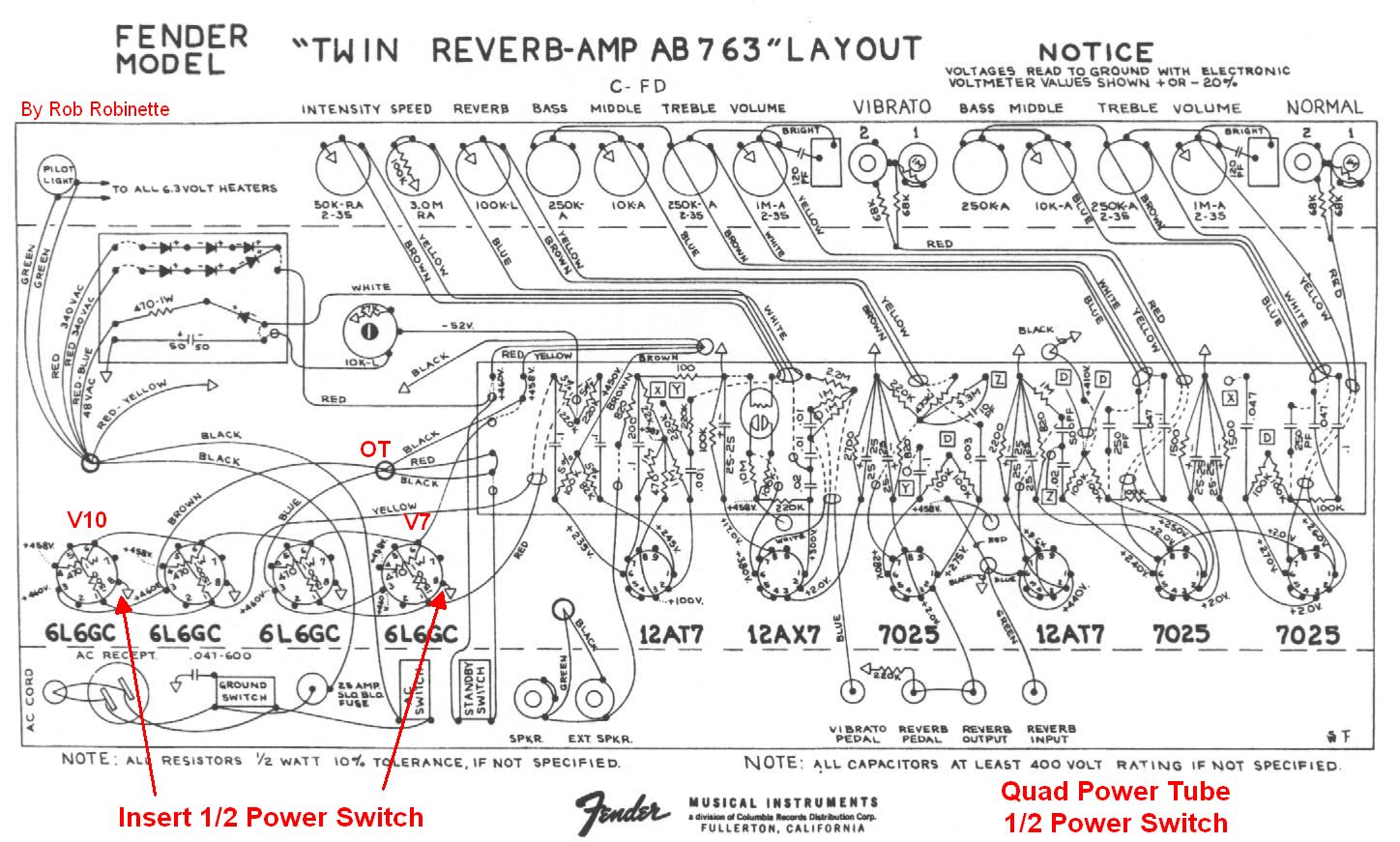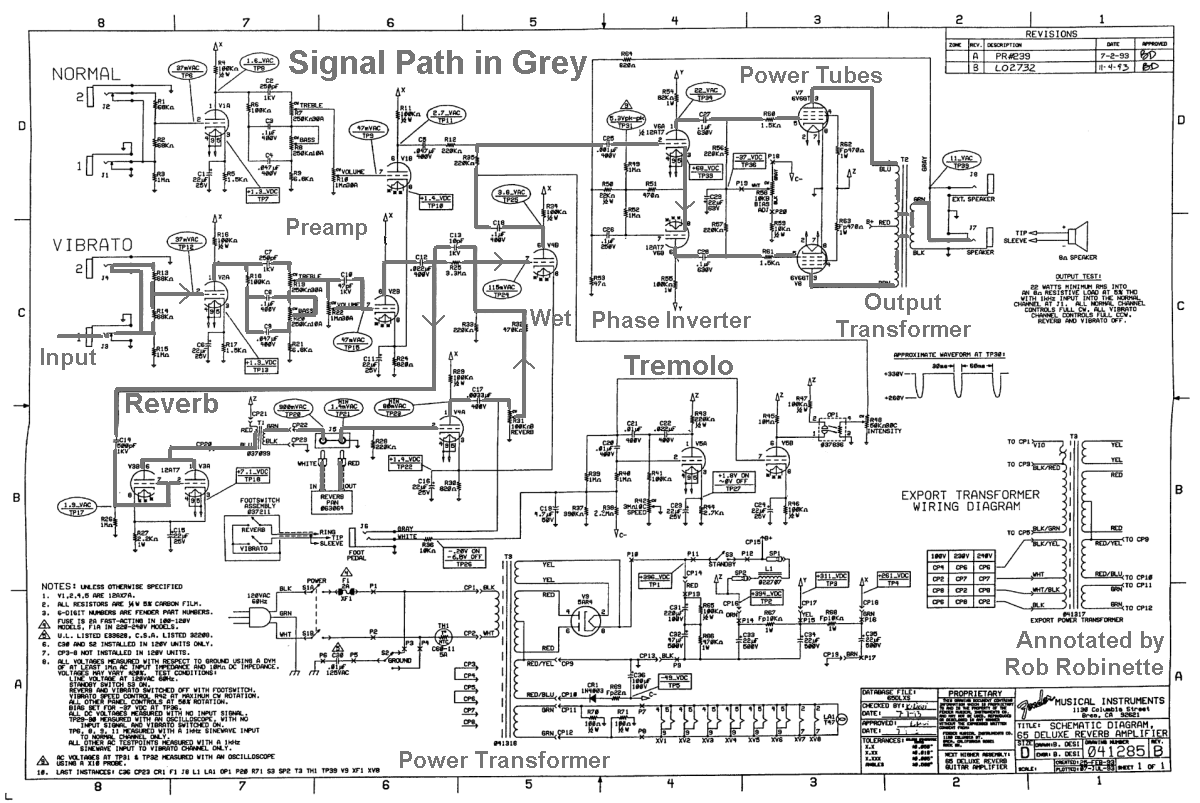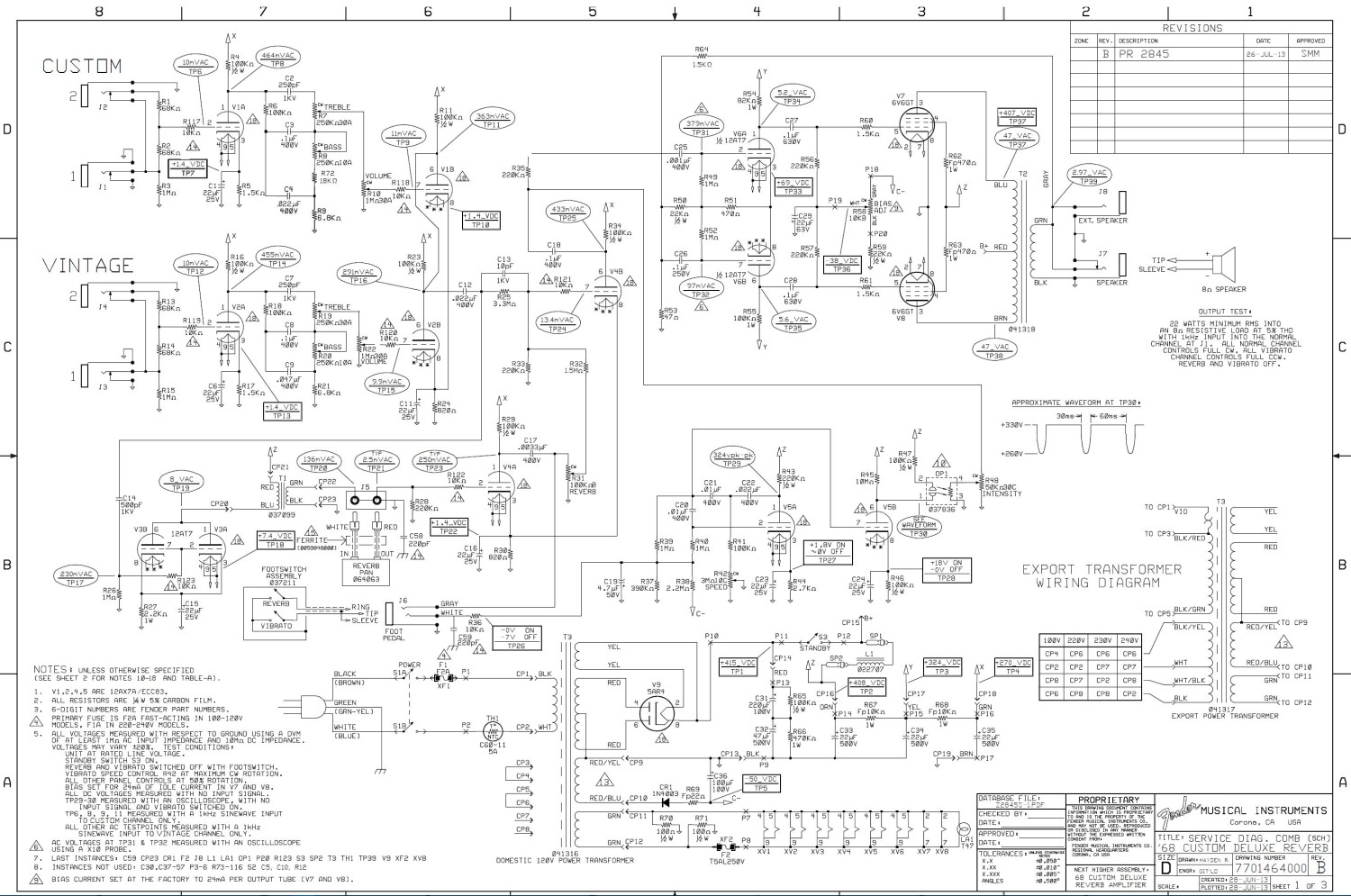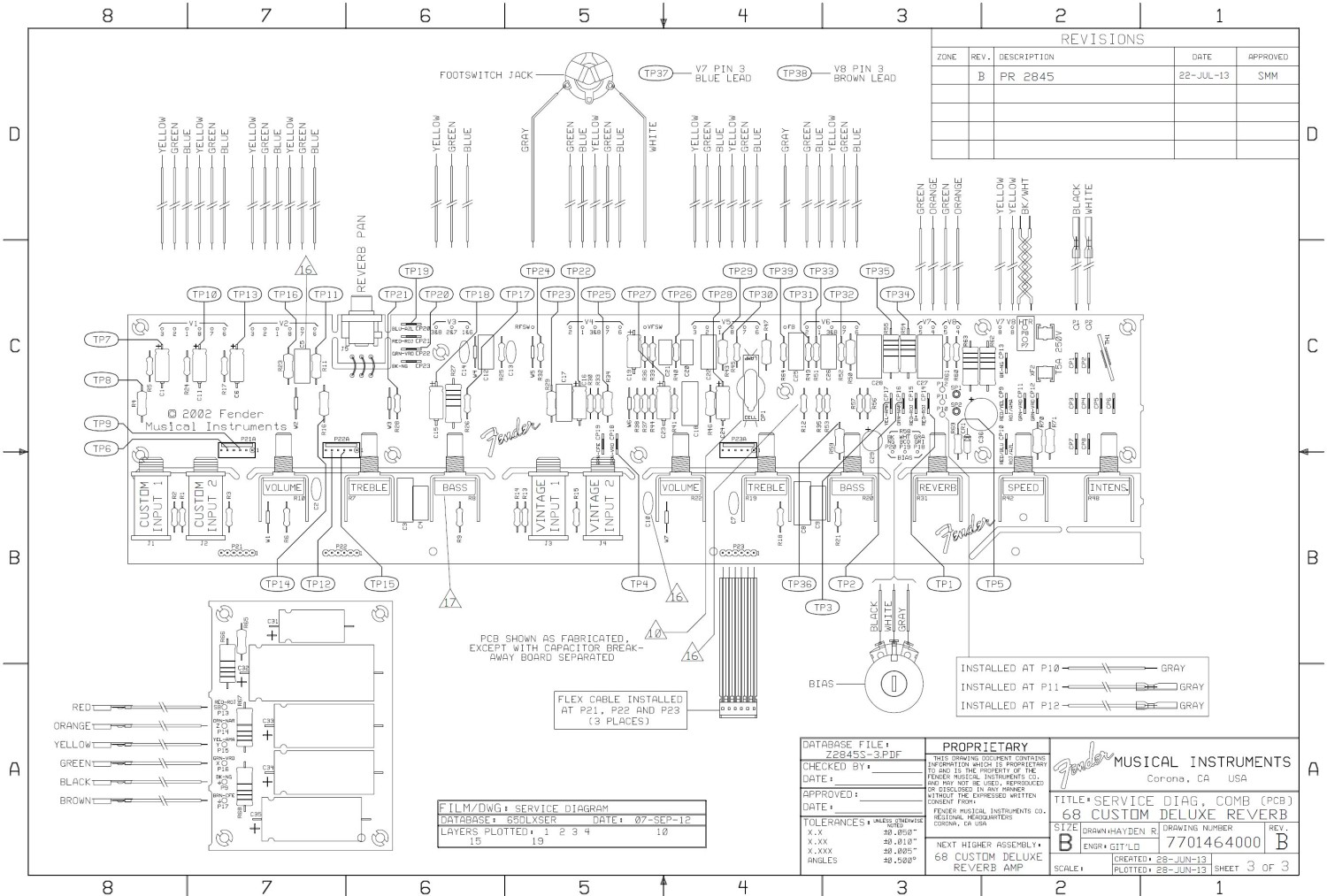AB763 Blackface Amp Model Differences
What's the difference between a blackface Tremolux and Vibrolux?
By Rob Robinette
Have comments or corrections? Email rob at: robinette at comcast dot net

'AB763' was Fender's internal model designation for the 1963 blackface circuit. "Blackface" refers to the panel color and 763 means July 1963. The circuit was used in the Deluxe, Deluxe Reverb, Twin Reverb, Super Reverb, Band-Master, Showman, Pro, Vibrolux, Vibroverb and Tremolux. Note there was no AB763 Champ, Princeton or Harvard because these little amps did not use a long tail pair phase inverter and so carried a different circuit designator. The AB763 circuit is considered by most to be the pinnacle of Fender amplifier design. This is why so many post-AB763 amps were "blackfaced" back to AB763 specs. The Deluxe Reverb schematic and layout below have been annotated with component functions so use them for AB763 circuit study. For more info on the AB763 amps see How the AB763 Works and AB763 Modifications.
The blackface tone is known for its "mid scoop." The AB763 TMB (Treble, Mid, Bass) tone stack sets this mid frequency scoop.
AB763 Mid Scoop With Treble and Bass Set to Maximum

With the Treble and Bass tone controls set to maximum the tone curve clearly shows the mid scoop. The Mid control is set to 6.8k to simulate the standard 6.8k Middle Resistor. Graph is from the excellent and free Duncan Tone Stack Calculator. See How the TMB Tone Stack Works for more info.
The basic AB763 circuit has two channels, both with a Hi and Low input, two or three preamp gain stages, a high output long tail pair (LTP) phase inverter driving two or four power tubes in a push-pull Class AB configuration. All of the AB763 amps have tremolo and some also have spring reverb. Most of the model differentiation comes from the power supply, the number of preamp stages, FX, power tube type and number, output transformer and speaker configuration. The lowly AB763 blackface Deluxe has anemic power and output transformers, two preamp stages, two small power tubes and a single 12 inch speaker driven by 22 watts. The mighty Twin Reverb has high output power and output transformers, three preamp gain stages, a no-sag solid state rectifier, four big power tubes and dual 12 inch speakers assaulted by 85 watts. The other AB763 amps fall between these two extremes.
All the AB763's with reverb have "verb" or "reverb" in their names. The blackface amps without reverb, the Deluxe, Vibrolux, Tremolux, Pro, Concert, Showman and Band-Master, have only two preamp gain stages compared to three stages in the Deluxe Reverb, Super Reverb, Vibroverb and Twin Reverb amps. The primary purpose of the extra gain stage is to make up for signal loss from the reverb circuit but the extra stage more than makes up for the loss and gives earlier dirt and more total distortion. The amps with two preamp gain stages can jumper their channels together for a fatter tone. Amps with three gain stages cannot jumper their channels because the Normal channel only uses the first two preamp stages and the Vibrato channel uses all three so the two channels are out of phase (each gain stage flips the signal voltage). Jumpering these amps won't damage them but the tone will be thin and funky. A simple AB763 mod to amps with three preamp gain stages can send both channels through the third preamp stage to allow jumpering.
The head cab AB763's, the Tremolux, Band-Master and Showman, use 50% smaller 500pF coupling caps leading to the phase inverter compared to the other amps' 1000pF (.001uF). This was done to reduce bass frequencies into the Fender closed back extension cabs which exhibit extended bass response compared to open back combo cabs. The smaller cap also tends to tighten up the overdrive tone.
The multi-speaker amps, the Tremolux, Band-Master, Concert, Super Reverb, Dual Showman and Twin Reverb use a "heavy" negative feedback (NFB) circuit compared to the other AB763 amps' "light" circuit. These multi-speaker amps used 2 and 4 ohm output transformer secondaries so the "heavy" NFB circuit compensated for the lower secondary voltages. The feedback circuit is made up of two NFB resistors that form a voltage divider. The "heavy" NFB circuit uses an 820 / 100 ohm divider while the others use a "light" 820 / 47 ohm circuit. The 820 / 100 "heavy" NFB circuit attenuates the output transformer secondary signal voltage by 89%. The 820 / 47 "light" NFB circuit cuts the signal by 95%.
The NFB voltage from an 8 ohm speaker output gives 41% more voltage than a 4 ohm. There's also a 41% increase when comparing a 2 and 4 ohm secondary. Fender used the "heavy" NFB circuit in the multi-speaker amps to compensate for their lower voltage delivered by their 2 and 4 ohm output transformer secondaries. The Concert and Super Reverb get 41% less negative feedback than all the other 6L6 amps due to their 2 ohm output.
Fender used the same NFB circuit in the 6V6, 2x6L6 and 4x6L6 amps even though their power amps put out different voltages. The result is the 2x6L6 amps get about 25% more NFB than the 2x6V6 amps and the 4x6L6 get around 30% more NFB than the 2x6L6 amps. This is one of the reasons the Twin Reverb sounds so clear and clean. Keep in mind the AB763 uses a lot of NFB and that's why Fender cut the NFB in half with their new 68 Custom Deluxe Reverb reissue by doubling the size of its NFB resistor to 1.5k. Personally I tend to prefer lower negative feedback with its thicker clean tone, earlier dirt and lazier transition to overdrive but there is an audible increase in resistor hiss from the speaker. Installing a switch to reduce NFB is an excellent AB763 mod.
The preamp tube plate voltage starts at a low 170v for the Deluxe and progresses up to 280v for the Vibroverb and Showman amps. Higher preamp voltage offers up more gain throughout the preamp and delivers more voltage swing to drive the power amp harder for more power tube distortion. The Deluxe and Deluxe Reverb's low preamp voltage doesn't hinder them because their small 6V6 power tubes don't need as much voltage input swing to overdrive them compared to the big 6L6.
The power tube plate voltage also varies between the AB763 amps. A higher plate voltage offers more power amp clean headroom with tighter lows and more overall volume.
The Concert, Band-Master, Showman and Twin Reverb use a solid state rectifier with less dynamic voltage sag than the tube rectified amps which leads to a tighter bottom end with more clean headroom and overall volume but playing dynamics are slightly reduced--the solid state rectifier amps feel a little less "tubey."
Output Transformers
The Deluxe and Deluxe Reverb use the little 125A1A 6.6k:8 ohm transformer with one speaker.
The Concert, Pro, Vibrolux and Vibroverb use the 125A7A 4k:8 ohm transformer with one speaker.
The Band-Master and Tremolux use the 125A6A 4k:4 ohm transformer with two speakers. This is the 4 ohm version of the 125A7A. The later silverface Bandmaster Reverb and Pro Reverb use the same output transformer.
The Super Reverb and Concert use the big 125A9A 4.2k:2 ohm transformer paired with 4x10" speakers for a tight, punchy bass.
The Single Showman uses the big 125A30A 2k:8 ohm speaker paired with a single speaker.
The Twin Reverb and Dual Showman use the big 125A29A 2k:4 ohm speaker with two speakers. This is the 4 ohm version of the 125A30A.
Power Transformers
The two 6V6 amps, the Deluxe and Deluxe Reverb use the little 125P23B transformer at 330-0-330 volts AC and GZ34 tube rectifier with 410v of B+.
The Tremolux and Vibrolux (2x6L6) use the slightly more powerful 125P26A 325-0-325VAC transformer and GZ34 tube rectifier with 410v of B+.
The Pro, Super Reverb and Vibroverb use the 125P5D 360-0-360VAC transformer and GZ34 tube rectifier with 460v of B+. The later silverface
The Band-Master and Concert use the 125P7D 320-0-320VAC transformer and solid state rectifier with 440v of B+.
All of the 4x6L6 amps, the Single & Dual Showman and Twin Reverb use the big 125P34A 340-0-340VAC transformer and solid state rectifier with 450 to 460v of B+.
Table of Contents and AB763 Overview
| Preamp Stages | FX | Preamp Plate V | Pwr Tube Plate V | Power Tubes | Rectifier | Speakers | 1964 Price | 2019 Adjusted* | |
| Deluxe | 2 | Tremolo | 170 | 410 | 2 x 6V6 | GZ34 | 1x12, 8 ohm | $169.50 | $1,380 |
| Deluxe Reverb | 3 | Tremolo & Reverb | 180 | 410 | 2 x 6V6 | GZ34 | 1x12, 8 ohm | $239.50 | $1,949 |
| Vibrolux | 2 | Tremolo | 200 | 410 | 2 x 6L6 | GZ34 | 1x12, 8 ohm | $299.50 | $2,437 |
| Tremolux | 2 | Tremolo | 200 | 410 | 2 x 6L6 | GZ34 | Head Cab, 4 ohm | $329.50 | $2,681 |
| Band-Master | 2 | Tremolo | 275 | 440 | 2 x 6L6 | Solid State | Head Cab, 4 ohm | $309.50 | $2,517 |
| Concert | 2 | Tremolo | 270 | 440 | 2 x 6L6 | Solid State | 4x10, 2 ohm | $369.50 | $3,006 |
| Pro | 2 | Tremolo | 275 | 460 | 2 x 6L6 | GZ34 | 1x15, 8 ohm | $299.50 | $2,437 |
| Vibroverb | 3 | Tremolo & Reverb | 280 | 460 | 2 x 6L6 | GZ34 | 1x15, 8 ohm | $339.50 | $2,762 |
| Super Reverb | 3 | Tremolo & Reverb | 270 | 460 | 2 x 6L6 | GZ34 | 4x10, 2 ohm | $399.50 | $3,251 |
| Showman | 2 | Tremolo | 280 | 460 | 4 x 6L6 | Solid State | Head Cab, 8 ohm | $640.00 | $5,205 |
| Dual Showman | 2 | Tremolo | 280 | 460 | 4 x 6L6 | Solid State | Head Cab, 4 ohm | $915.00 | $7,439 |
| Twin Reverb | 3 | Tremolo & Reverb | 270 | 460 | 4 x 6L6 | Solid State | 2x12, 4 ohm | $479.50 | $3,901 |
| 65 DRRI | 3 | Tremolo & Reverb | 190 | 415 | 2 x 6V6 | *5AR4 | 1x12, 8 ohm | $1,099 | |
| 68 CDR | 3 | Tremolo & Reverb | 190 | 415 | 2 x 6V6 | *5AR4 | 1x12, 8 ohm | $1,049 |
Notes: Amps with reverb have 3 preamp gain stages in the Vibrato channel with slightly more gain and preamp distortion. The Super Reverb has a larger, higher rated output transformer than the other 2 x 6L6 amps. *The 5AR4 rectifier is a GZ34 equivalent. *2019 inflation adjusted prices were calculated using the Bureau of Labor Statistics CPI Inflation Calculator.
Notice how similar the Tremolux and Band-Master head amps appear. The only difference between the two are the Band-Master's power transformer and solid state rectifier with higher preamp and power tube plate voltage. These differences lead to a "stiffer," less "tubey" tone with more clean headroom for the Band-Master. It's very easy to convert an inexpensive Band-Master head amp into a Tremolux.
I was surprised to see how expensive the non-reverb Showman amps were. The Showman head amps were sold with a matching extension cab and their price included the extension cab. Extension cabs for all the other head amps were an additional cost.
If you are considering building an AB763 with reverb in a head cab I recommend you go no smaller on the head cab dimensions than the silver face Dual Showman Reverb head cab. It allows for enough separation of the reverb tank and power transformer to keep hum pickup to a minimum. There's also enough room for the addition of a nice little 6" practice speaker.
Small Bottle AB763s
The 6V6 powered Deluxe and Deluxe Reverb are currently very popular due to their light weight and less than ear splitting dirty volume. The same long tail pair phase inverter drives both the 6V6 and 6L6 amps but the lower power 6V6 is overdriven at a lower input voltage than the 6L6 so the Deluxe and Deluxe Reverb offer up more and earlier power tube distortion than the big bottle AB763's.
The Deluxe and Deluxe Reverb both "suffer" from undersized power and output transformers but this leads to enhanced playing dynamics with more sag and bloom. The undersized power supply causes voltage sag which occurs when bass notes and power chords demand extra current the power supply can't supply so the voltage drops. This voltage sag causes compression because loud passages are held down by loss of voltage. The Deluxe amps' voltage sag and compression lead to a very lively, dynamic, tubey tone that many players love but their undersized transformers also lead to their biggest weakness: lack of clean headroom and a sometimes farty low end. Replacing the speaker with a more efficient one and increasing the size of the first filter caps can add some clean headroom and make the amp more gigworthy.
The negative feedback circuit is identical in the 6V6 and 6L6 AB763 amps so the lower voltage supplied by the 6V6 power amp leads to about 25% less negative feedback than the 2x6L6 amps and 47% less than the 4x6L6 amps. This is one reason the Deluxe and Deluxe Reverb get dirtier at lower volume settings than the 6L6 AB763 amps.
The Deluxe and Deluxe Reverb do not have a bright switch like the other AB763 amps but they do have a bright cap on their Vibrato channel.
You can get a different tone from these amps by installing 6L6 power tubes but the power and output transformers can't supply the extra current needed to actually get much more volume at the speaker. Running 6L6 tubes will stress the transformers so I don't recommend it.
AB763 Deluxe (Non-Reverb)
2 preamp gain stages, Tremolo, 2x6V6, 1x12 Speaker

The non-reverb Deluxe is the simplest amp of the family because it has only two preamp gain stages and no reverb. It has two triode light dependant resistor (LDR) signal tremolo but no reverb, 7025 (low noise version of the 12AX7) preamp, dual identical tone stacks with treble and bass controls for each channel (no Mid control), 12AT7 long tail pair phase inverter, two 6V6GT power tubes using adjustable fixed bias putting out about 22 watts of clean power into a single 12 inch speaker rated at 8 ohms. The non-reverb Deluxe has only one 16uF filter cap compared to the Deluxe Reverb's two. This makes the Deluxe's bottom end even more flabby than the Deluxe Reverb's.

The 47 ohm Negative Feedback Tail Resistor (highlighted at center) is replaced by a 100 ohm resistor in the multi-speaker AB763 amps to compensate for their 2 & 4 ohm output transformer secondaries which put out lower voltage. The Deluxe and Deluxe Reverb do not have a Bright Switch but they do have a Bright Cap on the Vibrato channel Volume pot. It smaller than other AB763 amps at 47pF.
AB763 Deluxe Reverb
3 preamp gain stages, Tremolo and Reverb, 2x6V6, 1x12 Speaker

This is "THE" Deluxe Reverb. The addition of reverb and a third preamp stage (V4B) are the only significant difference from the non-reverb Deluxe above but that third preamp stage adds quite a bit of additional gain. It comes with two 6V6GT power tubes putting out about 22 clean watts into a single 12 inch speaker rated at 8 ohms. If you are a fan of the Deluxe and Deluxe Reverb amps check out The Evolution of the Fender Deluxe and Deluxe Reverb.
AB763 Deluxe Reverb Annotated Schematic
Every component's function is listed so use this schematic for AB763 circuit study. Click image for full size, readable schematic. PDF is here.
AB763 Deluxe Reverb Signal Path
Signal path shown in thick red line above and color below. The signal path of all AB763 amps will be very similar to the schematic above and layout diagram below. The Vibrato channel Bright Cap, third stage preamp, 47 ohm NFB Tail Resistor and speaker rating are highlighted in red. These components vary between the AB763 models. Click image for clean schematic.
See How the AB763 Deluxe Reverb Works for more info on how the amp functions.
Guitar Signal Path
Click image for full size layout. PDF is here.
AB763 Deluxe Reverb Annotated Layout
Note the differences in the doghouse board at upper left. The first two filter caps (B+1) in the Deluxe Reverb are wired in parallel. The Deluxe has only one 16uF B+1 cap. All the other AB763 amps connect the first two filter caps (B+1) in series. The Voltage Dropping resistors are also different. Click the image for the hi-res layout. Download the pdf here and download the DIYLC file here.
AB763 Deluxe Reverb Annotated Original Layout
Click image for full size layout. PDF is here.
2 x 6L6GC Power Tube AB763s
These big bottle blackface amps are more gigworthy due to their increased power output than their small bottle siblings above. The Super Reverb has a larger 50 watt power transformer (same as the blackface Bassman) than the other 2 x 6L6 amps' 40 watt transformers. The larger transformer adds output volume and headroom and gives the Super Reverb a distinct tone.
The negative feedback circuit is identical in the 2x6V6, 2x6L6 and 4x6L6 AB763 amps so the higher voltage from the 2x6L6 power amp leads to 35% more negative feedback than the 6V6 amps. The 4x6L6 power amp supplies even more NFB voltage and delivers 30% more negative feedback than the 2x6L6 amps. Extra negative feedback tends to "civilize" an amp, add clean headroom and tighten the transition from clean to distortion.
You can safely run 6V6 power tubes in these amps if you replace the GZ34 rectifier tube with a lower voltage output 5Y3 which will bring down the amp's voltage enough to safely run the smaller tubes. There will be a speaker impedance mismatch but it's small enough for safe play through the built in speakers. Of course this is not possible in the amps with solid state rectifiers like the Band-Master, Twin Reverb and Showman but you can use a variac to lower the amp's input voltage on the solid state rectifier amps.
Note that you can not run EL34 tubes in AB763 amps because the power tube socket pins 1 and 8 are not tied together to support the EL34's suppressor grid. It is possible to relocate the 1.5k power tube grid stopper resistor tied to the power tube sockets' pin 1 and then jumper pins 1 & 8 together to allow EL34 use but their higher heater current demand will stress the power transformer.
AB763 Vibrolux
2 preamp gain stages, Tremolo, 2x6L6, 1x12 Speaker
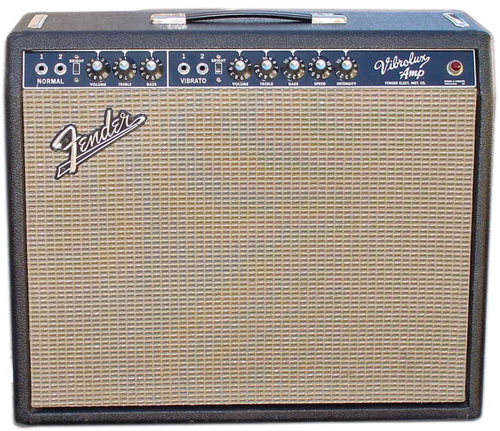
The Vibrolux is basically the non-reverb Deluxe with 6L6 power tubes. It has only two preamp stages like the non-reverb Deluxe above and shares its low voltage preamp. The low voltage preamp of the Vibrolux and Tremolux puts out lower gain and does not drive the two big 6L6GC tubes as hard as the other 6L6 AB763 amps resulting in less power tube distortion. It puts out about 35 watts of clean power into a 12 inch 8 ohm speaker which makes it loud enough to gig with but isn't nearly as heavy as the big 2x12 and 4x10 amps. The lack of reverb is the only chink in the Vibrolux's armor.
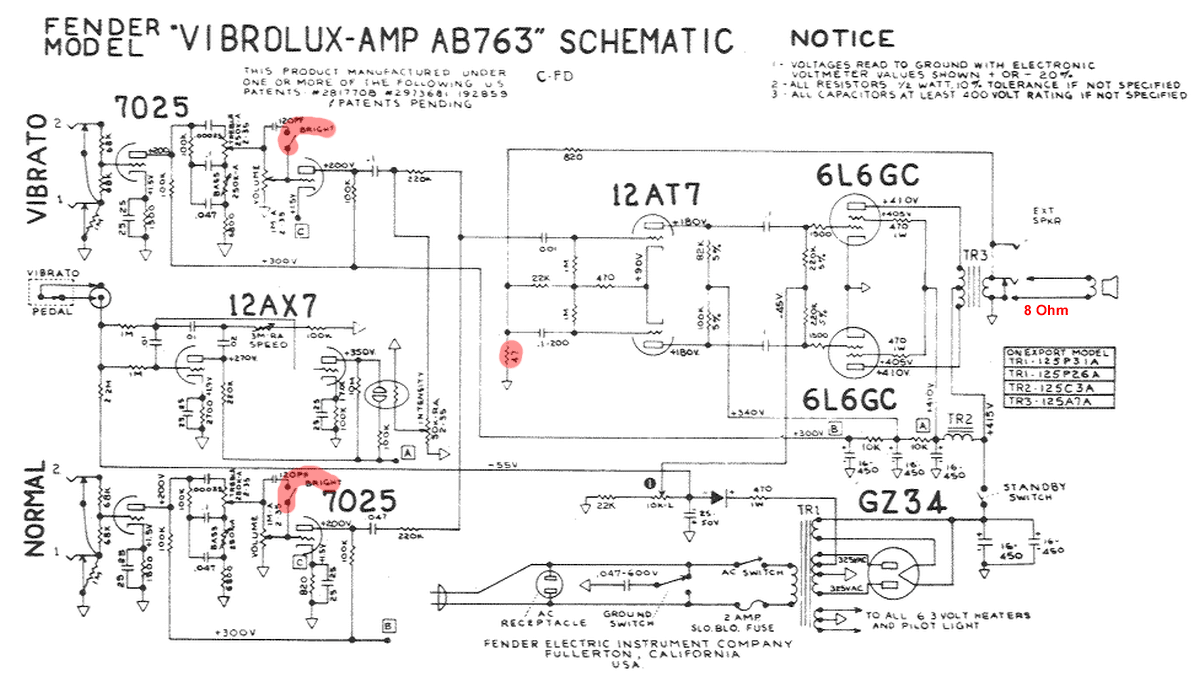
Note the Bright Cap Switches on both channels (highlighted in red on the left).
I could not find a Vibrolux layout diagram but it should be identical to the Tremolux (below in next section) except for the phase inverter coupling cap. It is .001uF (1000pF) in the Vibrolux and 500pF in the Tremolux. The smaller cap in the Tremolux head cab is used to trim some bottom end to compensate for the closed back extension cab's lower frequency response.
If you would like an inexpensive Vibrolux it's easy to convert an inexpensive Band-Master into a Vibrolux head or combo.
AB763 Tremolux
2 preamp gain stages, Tremolo, 2x6L6, Head Version of Vibrolux

The head cab Tremolux circuit is almost identical to the combo cab Vibrolux above. It puts out same power at about 35 watts clean. The low voltage preamp of the Vibrolux and Tremolux puts out lower gain and does not drive the two big 6L6GC tubes as hard as the other 6L6 AB763 amps resulting in less power tube distortion. The output transformer is different than the one in the Vibrolux and is rated for a 4 ohm load to drive two 1x12 eight ohm speakers wired in parallel mounted in a matching closed back cab. The Tremolux was dropped from the Fender lineup in 1966 so the Tremolux is somewhat rare.
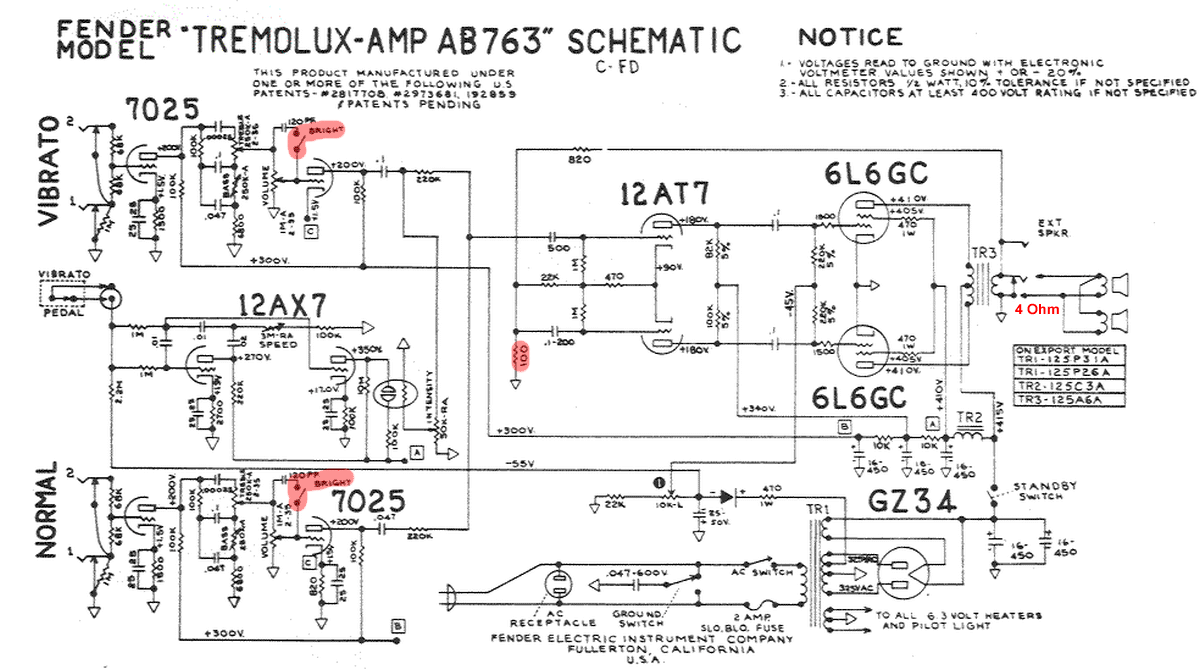
Note the 100 ohm negative feedback resistor (highlighted at center). All multi-speaker AB763's use a 100 ohm resistor compared to a 47 ohm for single speaker amps. Also note the 500pF phase inverter input coupling cap which was used to reduce bass frequencies into the Fender closed back extension cabs which exhibit extended bass response compared to open back combo cabs. The smaller cap would also tend to tighten up the overdrive tone. All the AB763 head cabs used this smaller cap.

The Vibrolux combo and Tremolux head are much more sought after amps these days than the Band-Master below but their differences are trivial and converting a Band-Master into a Vibrolux or Tremolux head or combo is an easy mod.
AB763 Pro
2 preamp gain stages, Tremolo, 2x6L6, 1x15 Speaker
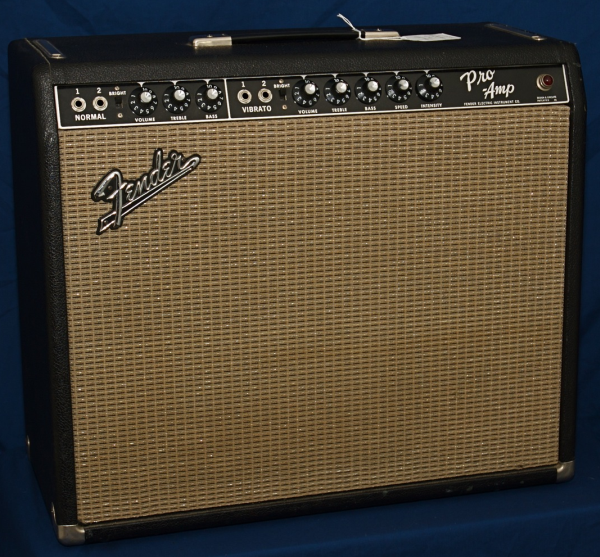
The Pro is pretty much a no-reverb Vibroverb with their signature 15 inch speaker. Many blackface amp fans think the Pro and it's head version, the Band-Master, as the sweet spot of the AB763 amps. Great gigging amps but not crazy loud like the 4x6L6 amps. The Pro has only two preamp gain stages like the Deluxe, Vibrolux, Tremolux and Band-Master. It has two 6L6GC power tubes putting out about 40 watts into a single 15 inch 8 ohm speaker. The Pro has no Middle tone controls. It comes with a beefier power transformer with higher output voltage than the Vibrolux. The lack of reverb is this amp's only weakness. In 1965 Fender dropped the AB763 Pro but added the AA165 Pro Reverb so the non-reverb Pro is somewhat rare.

Power tube plate voltage is higher than the Vibrolux at 440 volts and its output transformer is beefier for higher output.
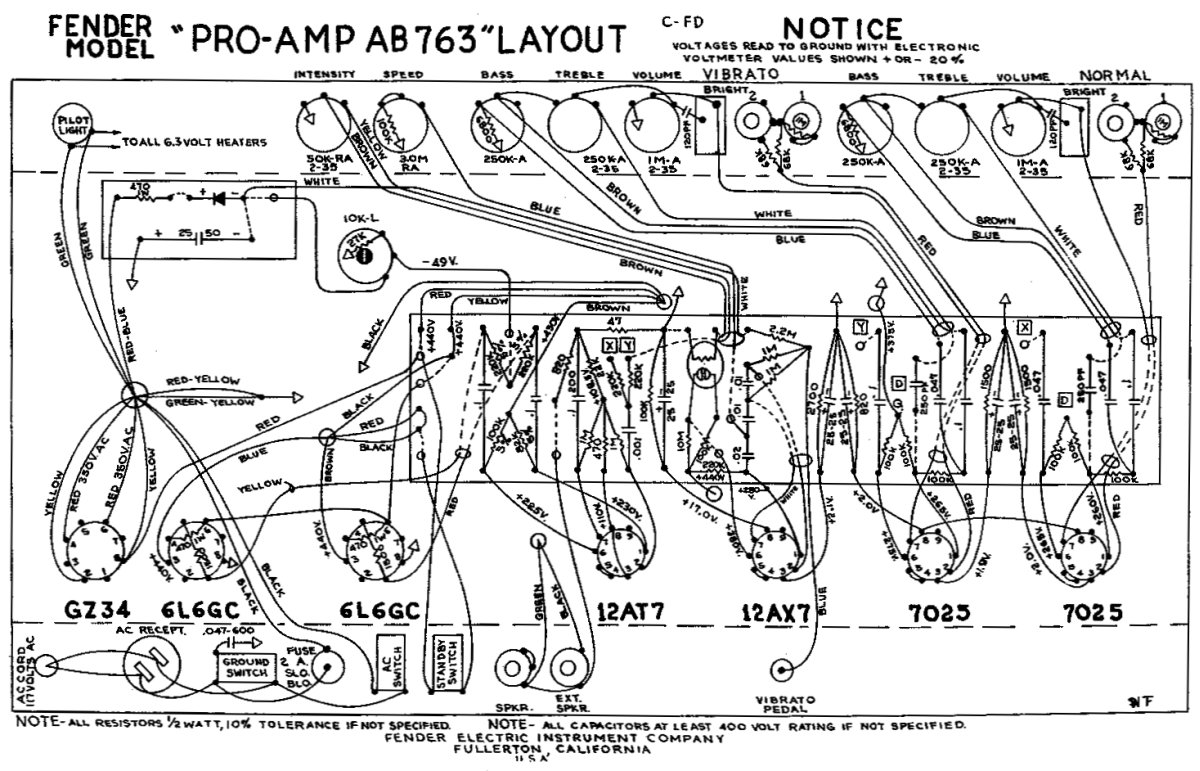
AB763 Band-Master
2 preamp gain stages, Tremolo, 2x6L6, Head Version of Concert & Pro

The Band-Master is considered to be the head cab version of the Concert and Pro but the Band-Master has a lower voltage power transformer rated at 320-0-320V AC + solid state rectifier, whereas the above Pro's transformer is rated at 350-0-350V and uses a GZ34 tube rectifier but the resulting rectifier voltage is identical. The Band-Master's solid state rectifier offers up a little less voltage sag than the Pro's tube rectifier so its tone is a little more tight and punchy with a firmer low end than the Pro. The output transformer is rated for a 4 ohm speaker load while the Pro is rated for a single 8 ohm speaker. The matching Band-Master speaker cab had two side-by-side 1x12 eight ohm speakers wired in parallel for a 4 ohm load in a sealed back cabinet. The Band-Master puts out around 40 watts.
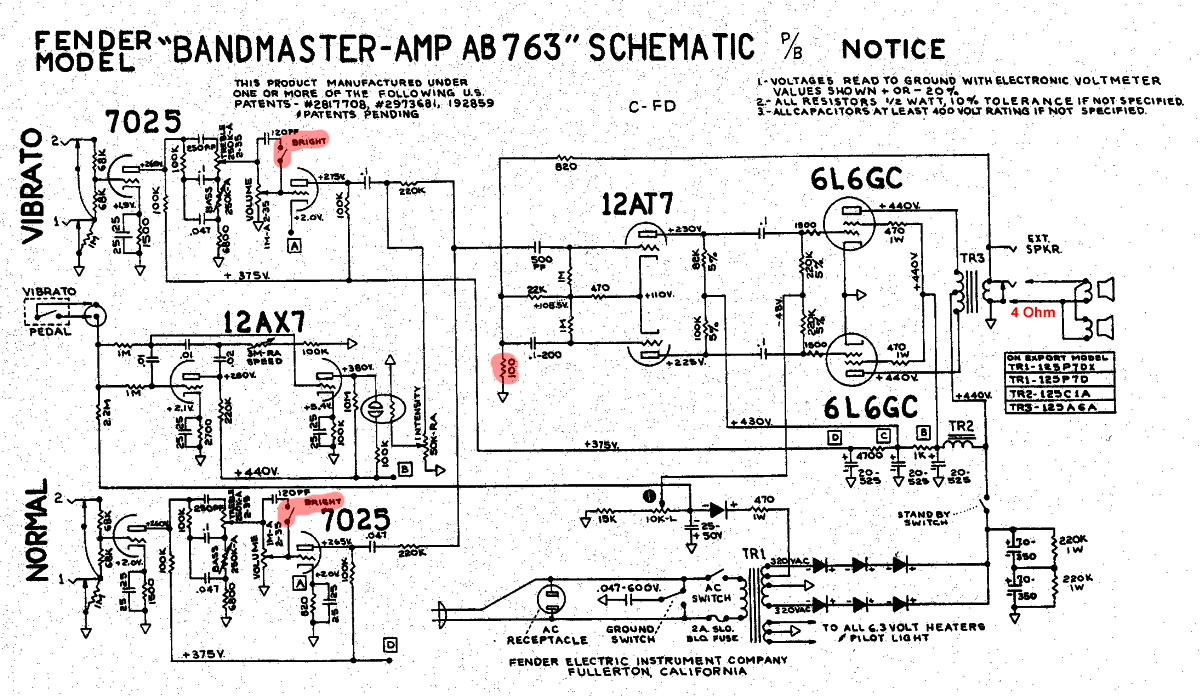
Note the solid state rectifier at lower right. Also note the 500pF phase inverter input coupling cap which was used to reduce bass frequencies into the Fender closed back cabs which exhibit extended bass response compared to open back combo cabs. The smaller cap would also tend to tighten up the overdrive tone. All the AB763 head cabs used this smaller cap.

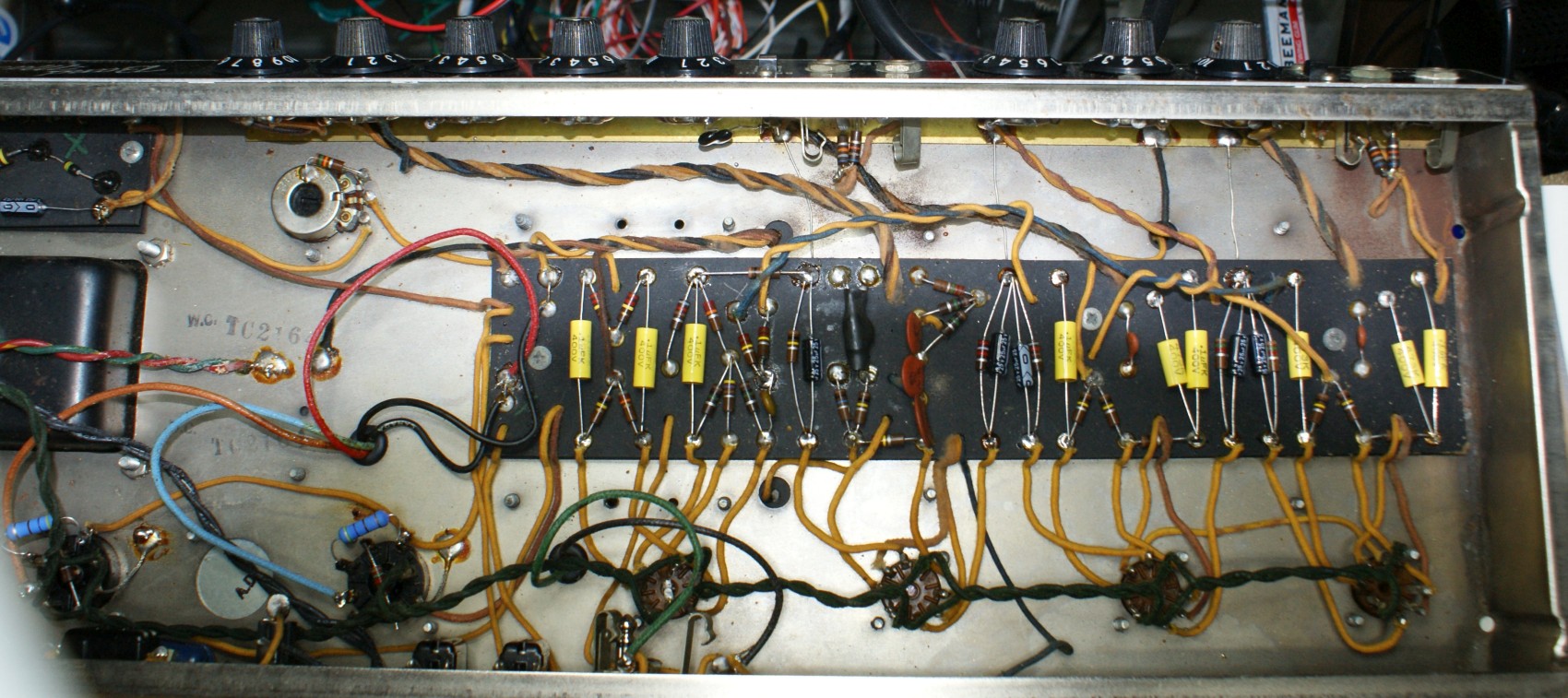
These Band-Master amps are inexpensive and easy to convert into a Vibrolux, Tremolux, Pro, Concert or no-reverb Vibroverb or Super Reverb head or combo.
AB763 Concert
2 preamp gain stages, Tremolo, 2x6L6, 4x10 Speakers

The Concert is another rare AB763 amp which is basically a Super Reverb without the reverb. Its four 10 inch speakers make it a big, heavy amp with great bottom end punch--even more than the Super Reverb. The major difference between their circuits is the Concert's solid state rectifier that reduces voltage sag and gives the Concert an even tighter bottom end but it does slightly reduce playing dynamics. Another difference is it does not have a Middle tone control like the Super Reverb. The Concert's 2 ohm output transformer supplies the negative feedback circuit with 41% less voltage so it has less negative feedback than the 4 and 8 ohm 6L6 AB763 amps (it would need an 870 / 200 ohm NFB circuit to get the same NFB voltage as the other amps). Lower negative feedback leads to a thicker clean tone, earlier dirt and a lazier transition to overdrive. The Super Reverb, Concert and 68 Custom Deluxe Reverb use .022uF mid caps where all other AB763's use .047uF.
Tone Stack Mid Caps
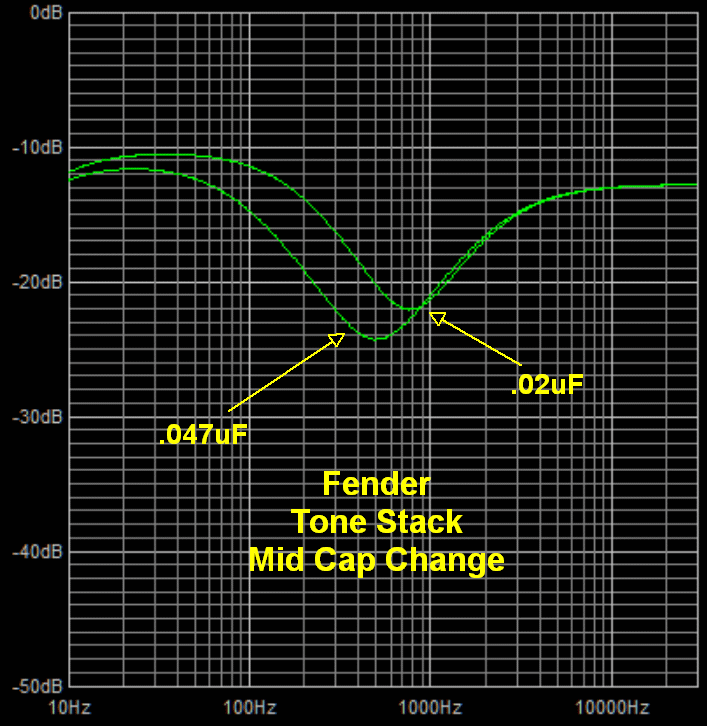
The Concert's reduced .022uF middle tone cap shifts the Mid tone control frequency band higher and reduces the mid scoop. Chart is from the Duncan Tone Stack Calculator.

AB763 Vibroverb
3 preamp gain stages, Tremolo and Reverb, 2x6L6, 1x15 Speaker

This is my personal favorite blackface amp. The Vibroverb is pretty much a Super Reverb with a smaller output transformer and 15 inch speaker--the circuits' only differences are the output transformer, the negative feedback circuit and the tone stack's mid caps. The Vibroverb's smaller output transformer adds a little more saturation, compression and sustain and thins the very low end a little compared to the Super Reverb. The Vibroverb has three preamp gain stages compared to the Pro's two for extra gain and dirt (the Pro is the other 15 inch AB763). The Vibroverb will be forever associated with Stevie Ray Vaughan's famous tone. This is the rarest and most valuable AB763 amp due to its short production run caused by the lack of popularity of 15 inch amps in the 60's.
The Vibroverb is big and bold due to its high power tube plate voltage, 15" speaker and 40 watts of output power but its tube rectifier still causes some voltage sag for a more dynamic, tubey vibe than the Twin Reverb and Dual Showman's solid state rectifier. The Vibroverb has no Middle tone controls.
Why is the Vibroverb my favorite AB763 amp? Because it has three preamp gain stages, reverb, high preamp voltage to drive the power tubes harder, a soft tube rectifier for extra playing dynamics, a match-more-external-speakers 8 ohm output, smaller output transformer for more compression and sustain and the bold tone of a 15 inch speaker.
Click on the layout to see the hi-res version. Download the pdf here. Download the DIYLC file here.
Fender Wire Routing
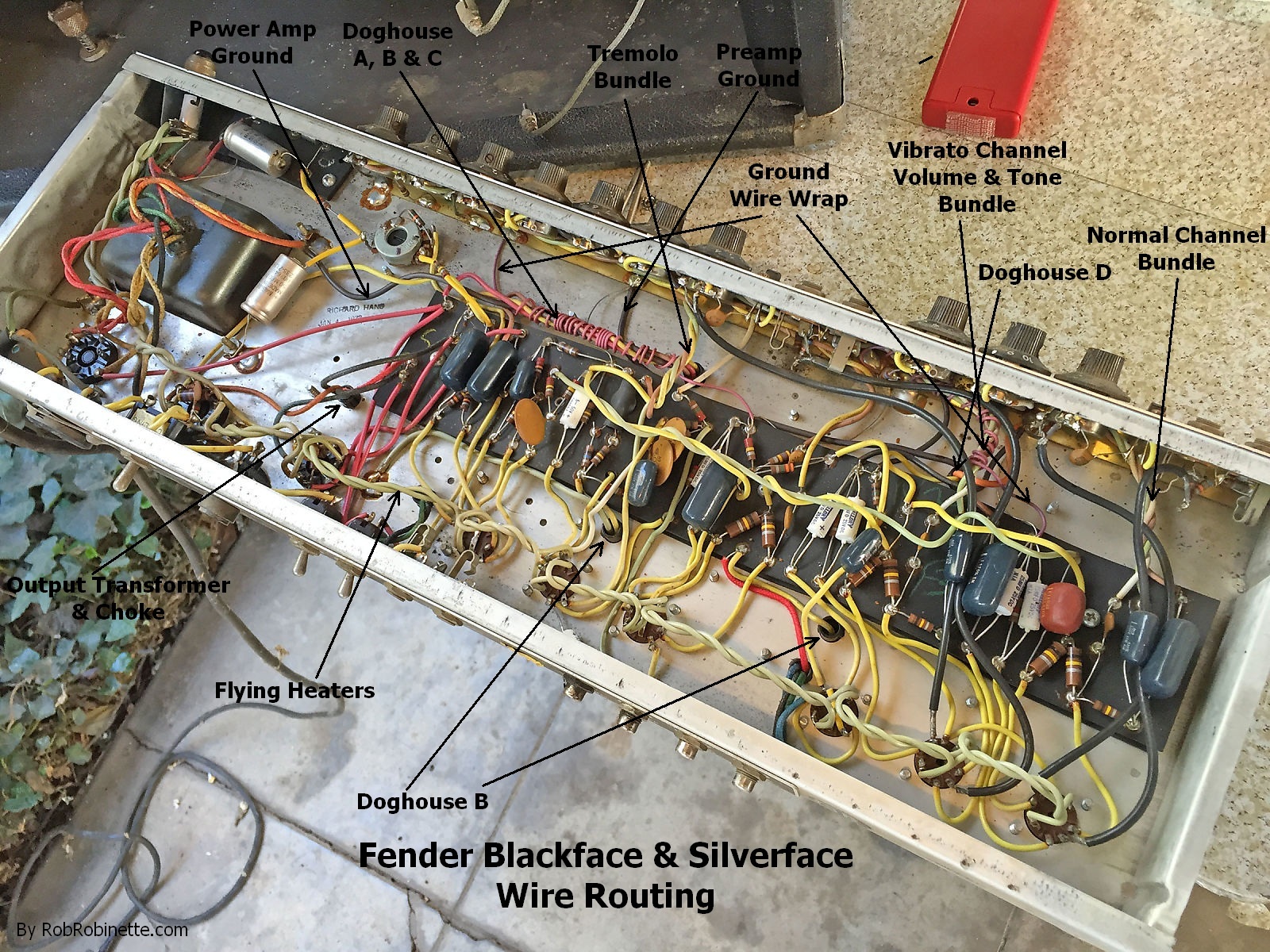
Note the two wire bundles that are wrapped with a reddish ground wire. The Vibrato channel volume and tone wires are wrapped and the Doghouse A, B & C power wires are wrapped. This was done as a "poor man's shield". Also notice how all the Tremolo wires are bundled and run along the chassis and then shoot straight down to their terminals. The tremolo wires carry a very strong signal that can bleed into other signal wires so pay close attention to their placement. This is my personal AA1069 silverface Bandmaster Reverb and it's a very quiet amp.

If you are considering building a blackface amp this is the one I recommend due to it's famous tone, gigability and its rareness and desirability will provide resale value for a well built amp. It's easy to convert a silverface Bandmaster Reverb head into a blackface Vibroverb.
AB763 Super Reverb
3 preamp gain stages, Tremolo and Reverb, 2x6L6, 4x10 Speakers, larger 50 watt output transformer
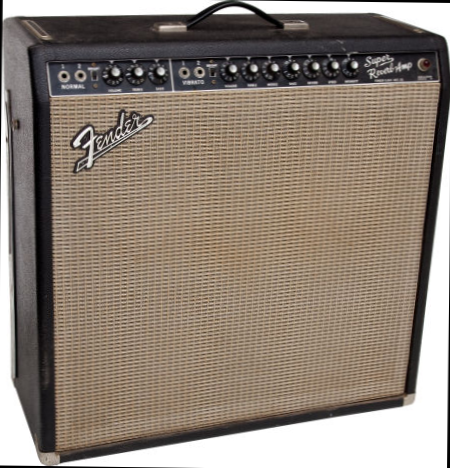
The Super Reverb features four 10 inch, eight ohm speakers and an upgraded output transformer that make it a big, heavy amp with great bottom end punch and lots of output volume--it's almost as loud as the Twin Reverb. The Super Reverb has a larger 50 watt power transformer (same as the blackface Bassman) than the other 2 x 6L6 amps' 40 watt transformers. The larger transformer adds output volume and headroom and gives the Super Reverb a distinct voice.
With a whopping 460 volts on the power tube plates the Super Reverb puts out about 40 watts into a 2 ohm speaker load. The Vibrato channel has a Middle tone control. The Super Reverb's 2 ohm output transformer supplies the negative feedback circuit with 41% less voltage so it has less negative feedback than the 4 and 8 ohm 6L6 AB763 amps (it would need an 870 / 200 ohm NFB circuit to get the same NFB voltage as the other amps). Lower negative feedback leads to a thicker clean tone, earlier dirt and a lazier transition to overdrive. The Super Reverb, Concert and 68 Custom Deluxe Reverb use .022uF mid caps where all other AB763's use .047uF.
Tone Stack Mid Caps

The Super Reverb's reduced .022uF middle tone cap shifts the Mid tone control frequency band higher and reduces the mid scoop. Chart is from the Duncan Tone Stack Calculator.
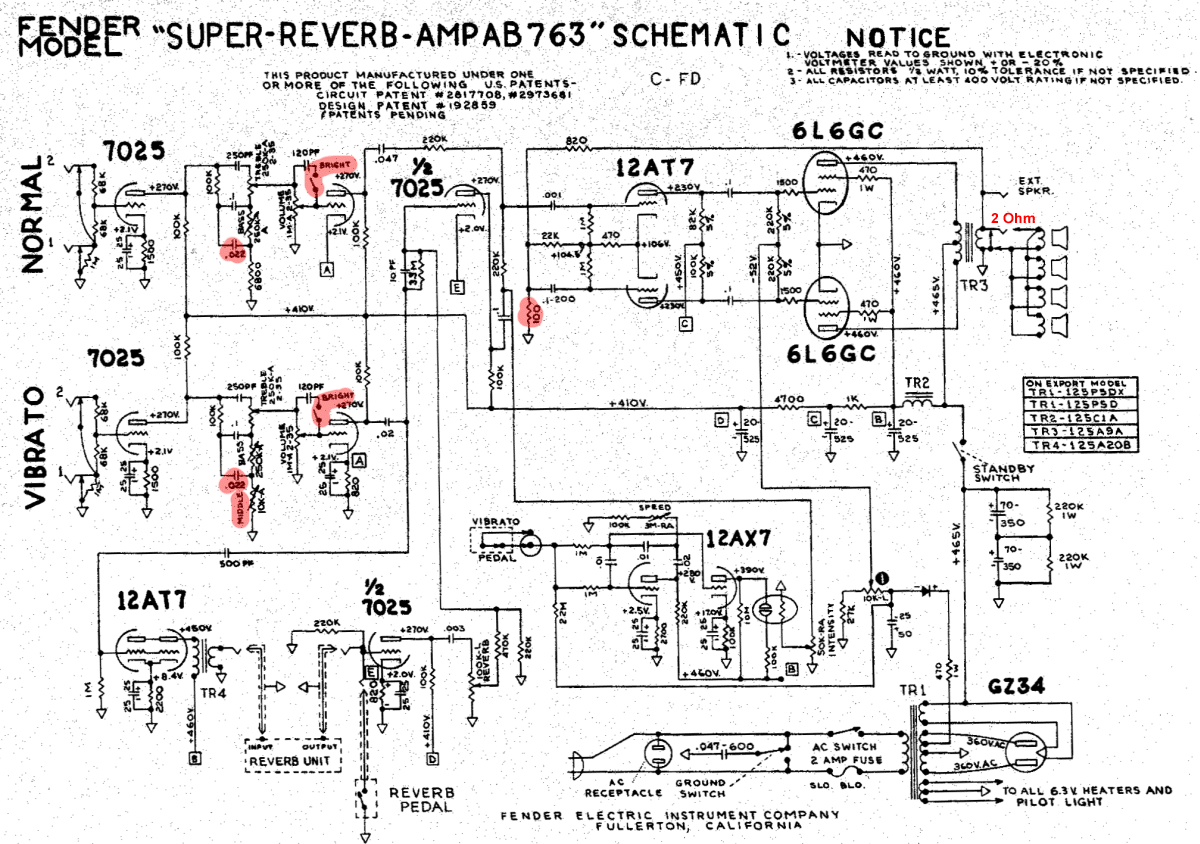
Note the .022uF middle tone caps, 2 ohm output transformer and the Middle tone control on the Vibrato Channel (highlighted center-left).
Use this layout for AB763 Circuit Study. Model differences are highlighted in pink. Click on the layout to see the hi-res version. Download the pdf here. Download the DIYLC file here.
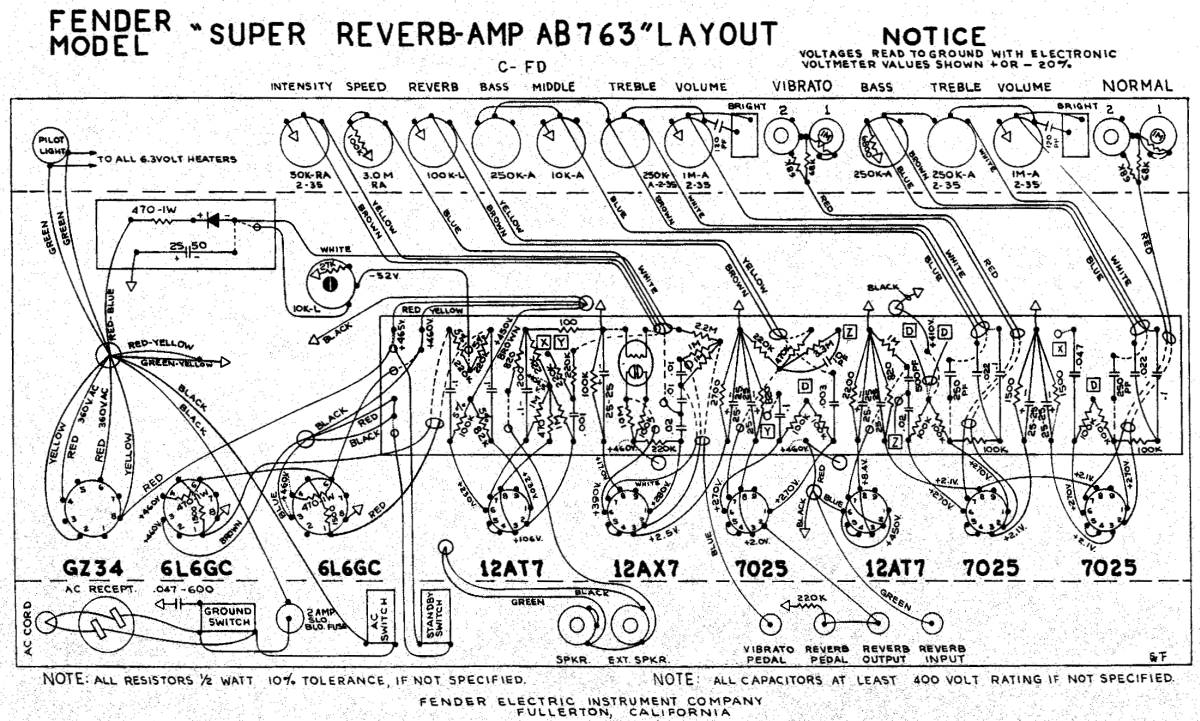
Note the Middle tone control on the Vibrato Channel.
4 x 6L6GC Power Tube AB763s
These are the big guns of the AB763 lineup putting out about 85 watts to offer up large venue volume.
The negative feedback circuit is identical in the 6V6, 2x6L6 and 4x6L6 AB763 amps so these 4x6L6 power amps supply even more NFB voltage which delivers 30% more negative feedback than the 2x6L6 AB763s. Extra negative feedback tends to "civilize" an amp, add clean headroom and tighten the transition from clean to distortion. This is one reason these high power amplifiers offer up so much clean headroom.
AB763 Showman
2 preamp gain stages, Tremolo, 4x6L6, Head Cab Version of Twin Reverb
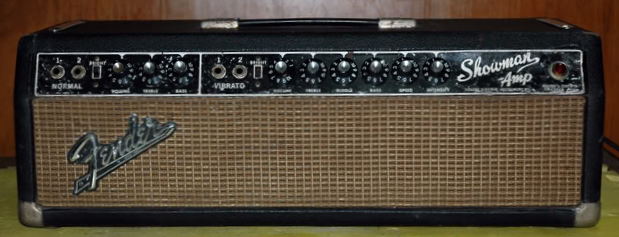
The Showman and Dual Showman are sometimes considered head cab versions of the Twin Reverb but they do not have reverb or a third preamp gain stage like the Twin. Surprisingly the non-reverb Showman amps with their included extension cabs were almost twice as expensive as the Twin Reverb. Fender marketed the Showman amps as the ultimate music professional's amp. Some Dual Showman amps have a "Showman" label on the amp face while others have "Dual Showman". The only differences between the Dual and Single Showman are the output transformer (4 ohm Dual or 8 ohm Single) and NFB circuit. The Single Showman is the only AB763 head amp designed to drive a single speaker.
The Showman amps use the same power transformer as the Twin Reverb. They all use a solid state rectifier for a firmer low end and more clean headroom. They put out about 85 watts of power like the Twin Reverb. The Single Showman is designed for a single 8 ohm speaker load and was typically mated to a single 12 or 15 inch speaker in a matching closed back extension cab. The Dual Showman uses a 4 ohm speaker load and was paired with a matching 2x15 extension cab with dual 8 ohm speakers wired in parallel. The extra 15 inch speaker made the Dual Showman a much louder amp. You can of course pair a Single Showman with a 2x15 cab with two 16 ohm speakers wired in parallel for an 8 ohm load and get the same tone and volume as the Dual Showman.
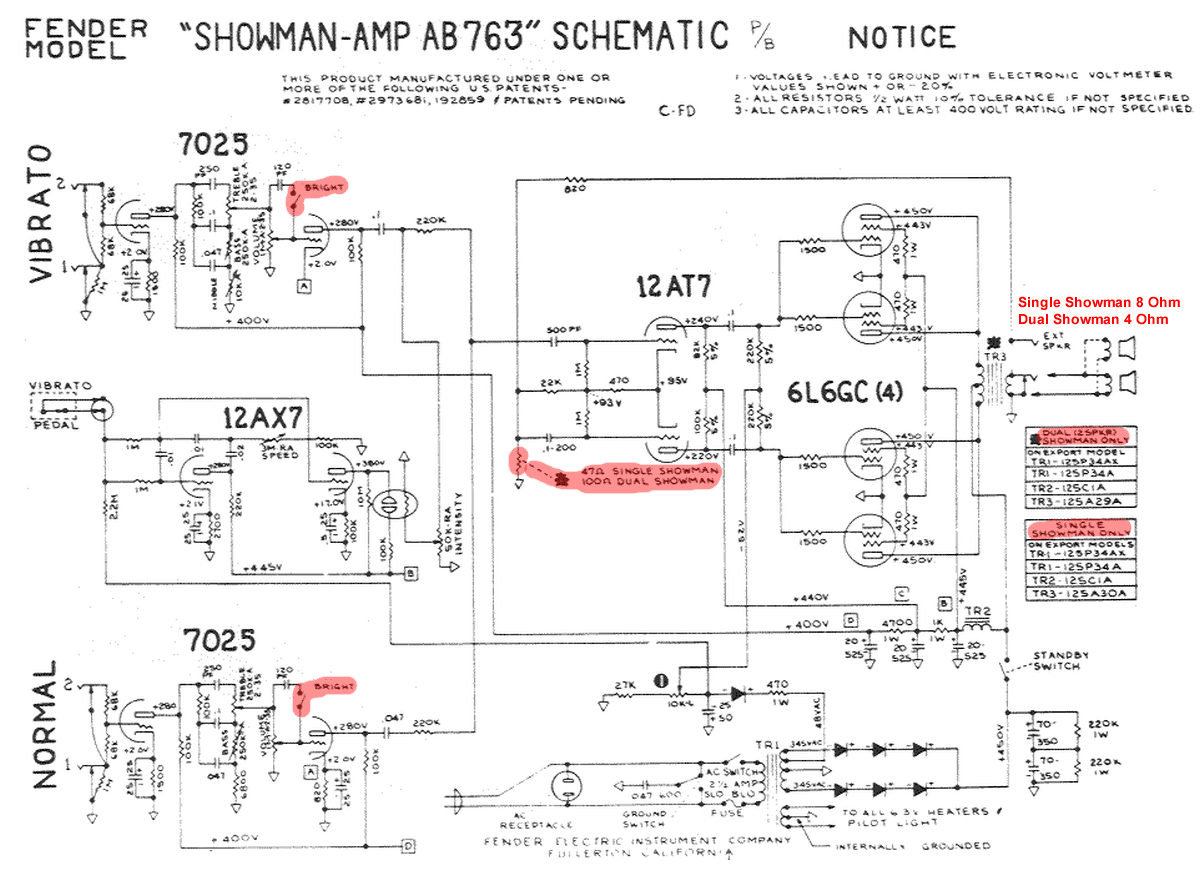
Note this schematic is for both the Single and Dual Showman--see boxes at right. The Single Showman uses a 47 ohm NFB Tail Resistor while the Dual uses a 100 ohm to compensate for it's lower voltage output. Also note the 500pF phase inverter input coupling cap which was used to reduce bass frequencies into the Fender closed back extension cabs which exhibit extended bass response compared to open back combo cabs. The smaller cap would also tend to tighten up the overdrive tone. All AB763 head cabs use this smaller cap.
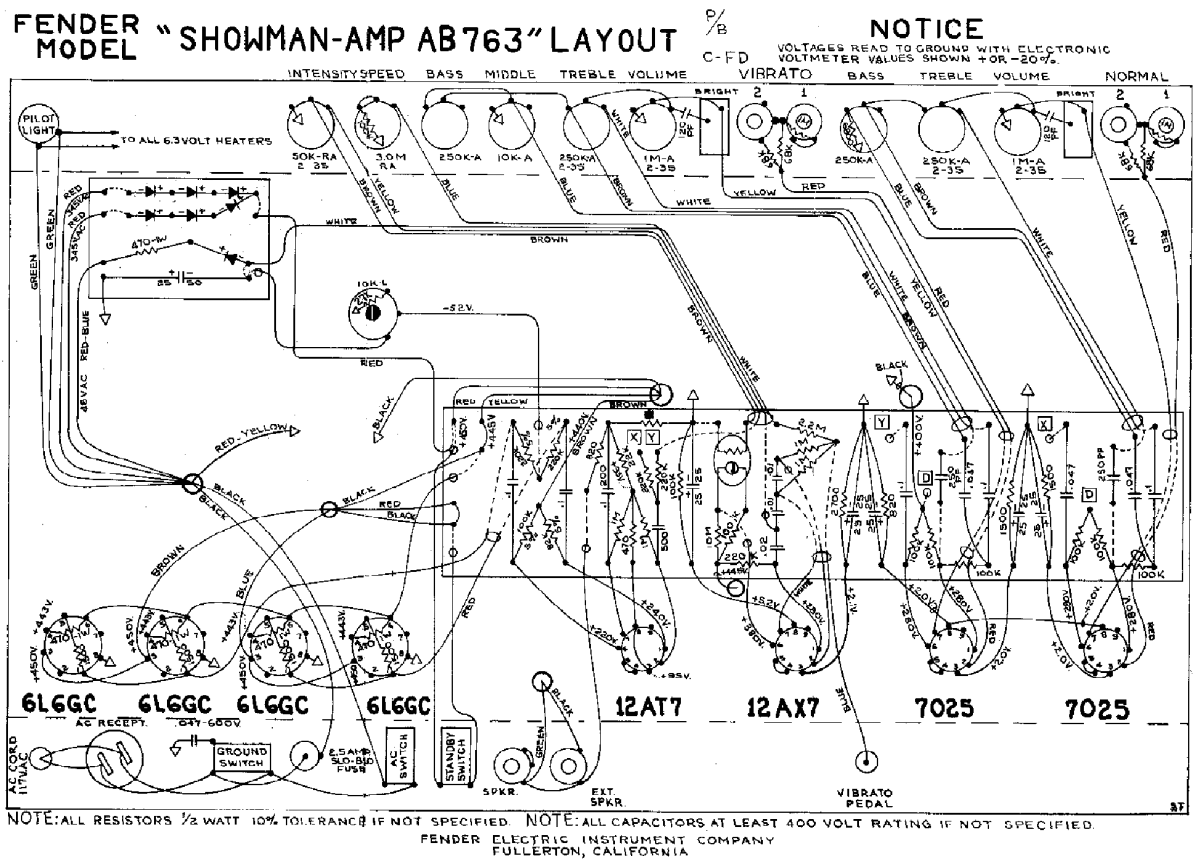
AB763 Twin Reverb
3 preamp gain stages, Tremolo and Reverb, 4x6L6, 2x12 Speakers, The Master & Commander of AB763 Amps
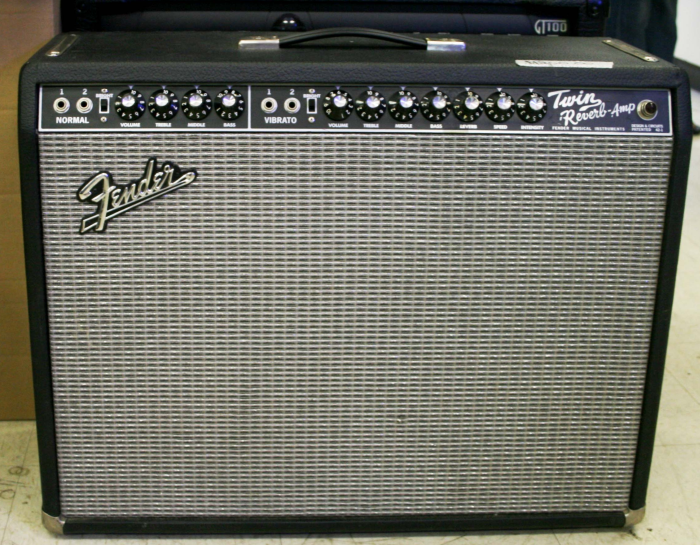
The Twin Reverb sports four 6L6GC power tubes and 85 watts of power into a 4 ohm speaker load. It also has additional tone control pots, the "Middle" control for both channels, where most of the other AB763 amps have a fixed Middle tone resistor.
Twin Reverb = Standard AB763 circuit + Middle tone pot + four 6L6GC power tubes + solid state rectifier + 2x12 Speakers = tons of clean headroom and stadium filling volume. The big downside of this amp is the extreme weight. If you must put casters on this amp make sure the wheels are soft rubber to minimize vibration and moving damage.
A solid state rectifier offers very little dynamic voltage sag so the Twin and Showman have tons of headroom and stay clean to crazy high volume levels. Because of this they make excellent pedal platforms--they stay clean so the pedals can do their thing.
If you want to put your Twin Reverb chassis in a head cab have a cab maker such as Mojotone.com build a Dual Showman Reverb cab for you and the amp chassis will slide right in.
Some of the major differences between the Twin Reverb and other AB763 amps are highlighted.
Click the image to see the hi-res version. The pdf is available here. The DIYLC file is available here.
AB763 With Tremolo Deleted
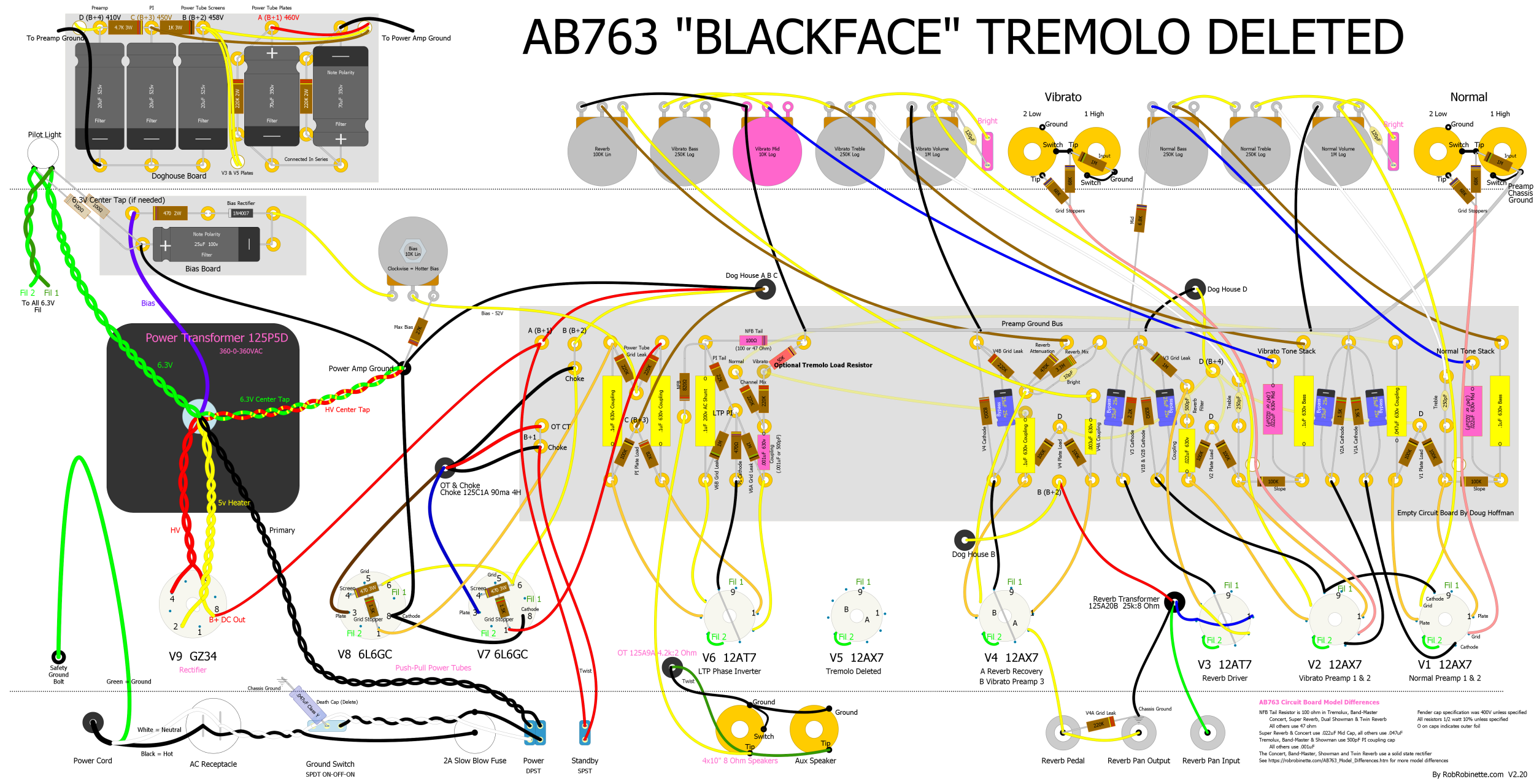
AB763 Vibroverb with reverb but tremolo has been deleted. V5 was used for tremolo so it is unused in this layout. Note the "Optional Tremolo Load Resistor" at center left of the circuit board. It applies the same circuit load as the tremolo to keep the Vibrato Channel's gain exactly the same as a normal AB763 blackface amp.
Reissues
AB763 based amps are still strong sellers for Fender over 40 years after their release. Fender sells reissues of the AB763 Deluxe Reverb, Vibrolux, Twin Reverb and Super Reverb.
AB763 Based 65 Deluxe Reverb Reissue (DRRI)
3 preamp gain stages, Tremolo and Reverb, 2x6V6, 1x12 Speaker

The AB763 circuit on a PCB instead of an eyelet based circuit board. Amp repairs and modifications with a PCB can be more difficult. The 5AR4 rectifier is a GZ34 equivalent. Download the Reissue '65 Deluxe Reverb Owners Manual. See the 65 DRRI modifications at the AB763 Modifications page. It's pretty easy to convert a 65 DRRI into a 68 CDR.
'65 Deluxe Reverb Reissue Signal Path
Click image for full size clean schematic.
65 Deluxe Reverb Reissue PCB Layout
Click the image for the full size layout.
AB763 Based 68 Custom Deluxe Reverb (CDR Reissue)
3 preamp gain stages, Tremolo and Reverb, 2x6V6, 1x12 Speaker
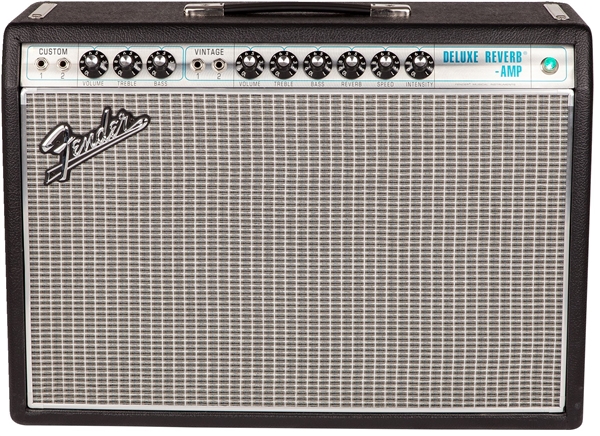
The 68 CDR is not a silverface amp, it is an almost exact copy of the 65 Deluxe Reverb Reissue with just a few valuable tweaks. I like to think of it as a silverface amp that's been blackfaced and then modified. Differences from 65 Deluxe Reverb Reissue include: Reverb and tremolo are available on both Vintage & Custom channels and both channels go through the third preamp gain stage V4B so both channels are now in phase so you can jumper channels for a thicker tone.
Negative feedback is cut in half compared to the Deluxe Reverb which brings on earlier dirt and a thicker clean tone but noticeably increases hiss.
Vibrato channel bright cap has been removed.
Fender describes the Custom channel as having a "modified" Bassman tone stack.
10k grid stopper resistors are added to the 2nd and 3rd preamp stages to help control overdrive behavior and sweeten the overdrive tone.
The reverb circuit uses a 1.5M vs 470k Reverb Attenuation resistor (R32) which adds attenuation and slows the action of the reverb pot as it's turned up making the control less twitchy.
The 5AR4 rectifier is a GZ34 equivalent. The 68 CDR's PCB circuit board is very similar to the 65 DRRI's layout above in the previous section. 68 CDR mods are here.
68 Custom Deluxe Reverb Schematic
Click the image for the full size schematic.
68 Custom Deluxe Reverb PCB Layout
Click the image for the full size layout.
Tone Stack Comparison


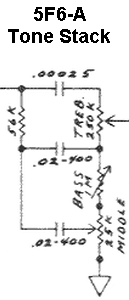
68 CDR Vintage channel on left, Custom channel in center, 5F6-A Bassman on right. The center Custom channel tone stack is supposed to be a modified version of a Bassman tone stack but I don't see much similarity with THE Bassman stack. The Bass cap is five times larger, the slope resistor is 80% larger, the Bass pot is 75% smaller, two Mid resistors replace the 25k Mid pot to simulate a 25k pot set to 6.8k. The added 18k resistor also acts as a "bass floor" to limit how low you can set the bass. The treble control is a high-pass filter and the bass and mid controls are band-pass filters with the 100k slope resistor setting the upper frequency limit and the bass pot and 6.8k mid resistor setting the lower. See How the TMB Tone Stack Works for more info.
Tone Stack Mid Cap Change

The only difference between the two 68 CDR tone stacks is the 18k resistor and the middle cap. The Custom channel's reduced .02uF middle cap shifts the "mid" frequency band higher and reduces the mid scoop. Chart is from the Duncan Tone Stack Calculator. Download the 68 CDR Vintage channel, 68CDR Custom channel and 5F6-A Bassman Duncan Tone Stack Calculator files.
Customizing and adding the effects to the old "Normal" channel makes the 68 CDR more versatile because many Deluxe Reverb players never used the Normal channel. The 68 CDR's Vintage channel is the old "Vibrato" channel. The bright cap on the Vibrato volume pot has been removed to reduce ice pick highs. The added tone stack 18k resistor acts as a "bass floor" and sets the minimum bass. Some 68 CDR owners have jumpered around this resistor to allow them to set a lower bass level. British voiced 12” Celestion G12V-70 speaker is used. Blue jewel light (sweet!). Reviews of this amp are very favorable.
It's pretty easy to convert a 65 DRRI into a 68 CDR.
Fender 1963 Catalog Amp Listings
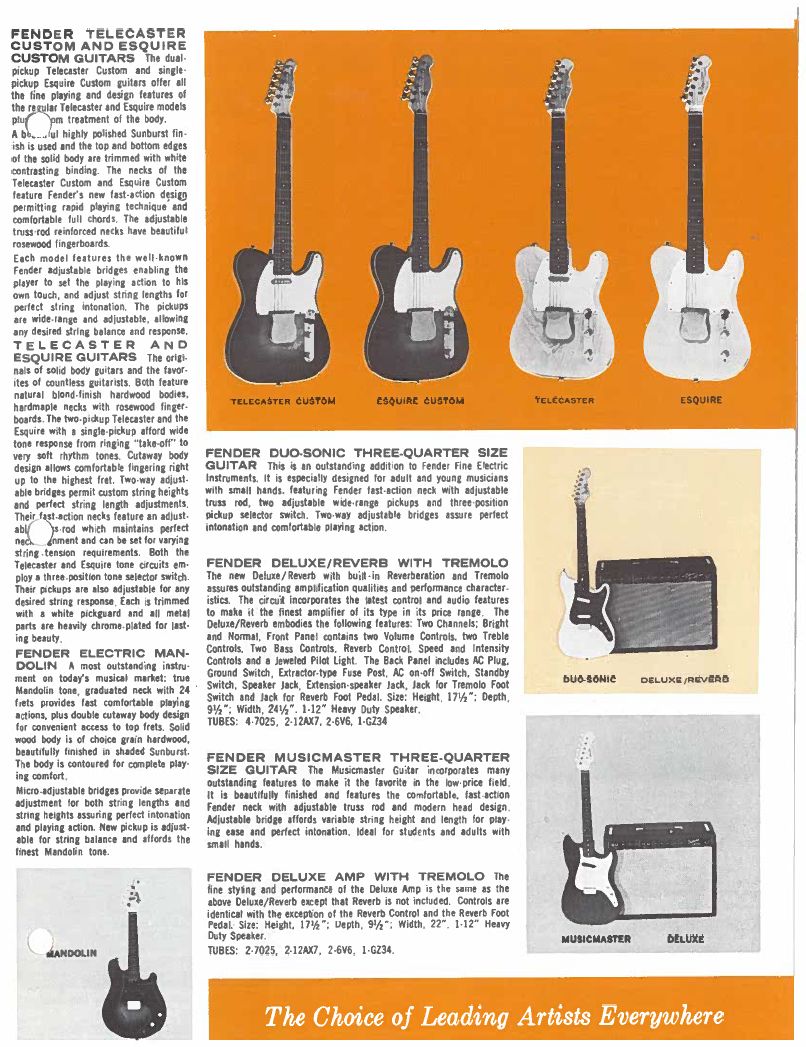
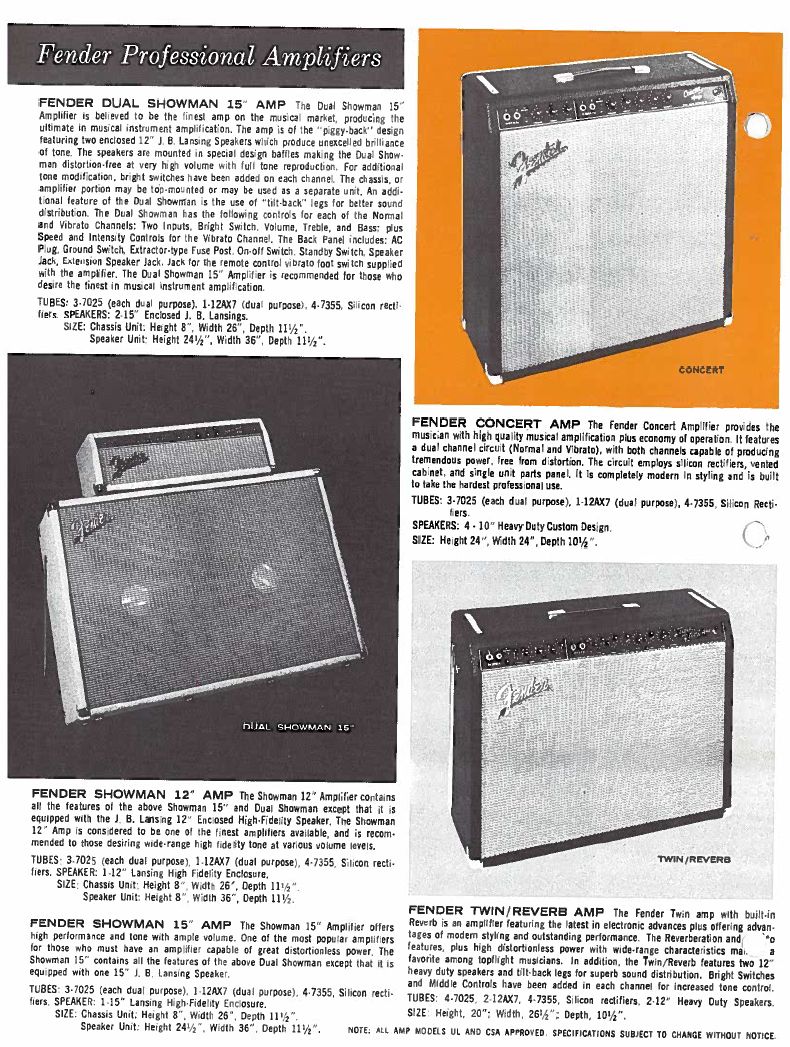
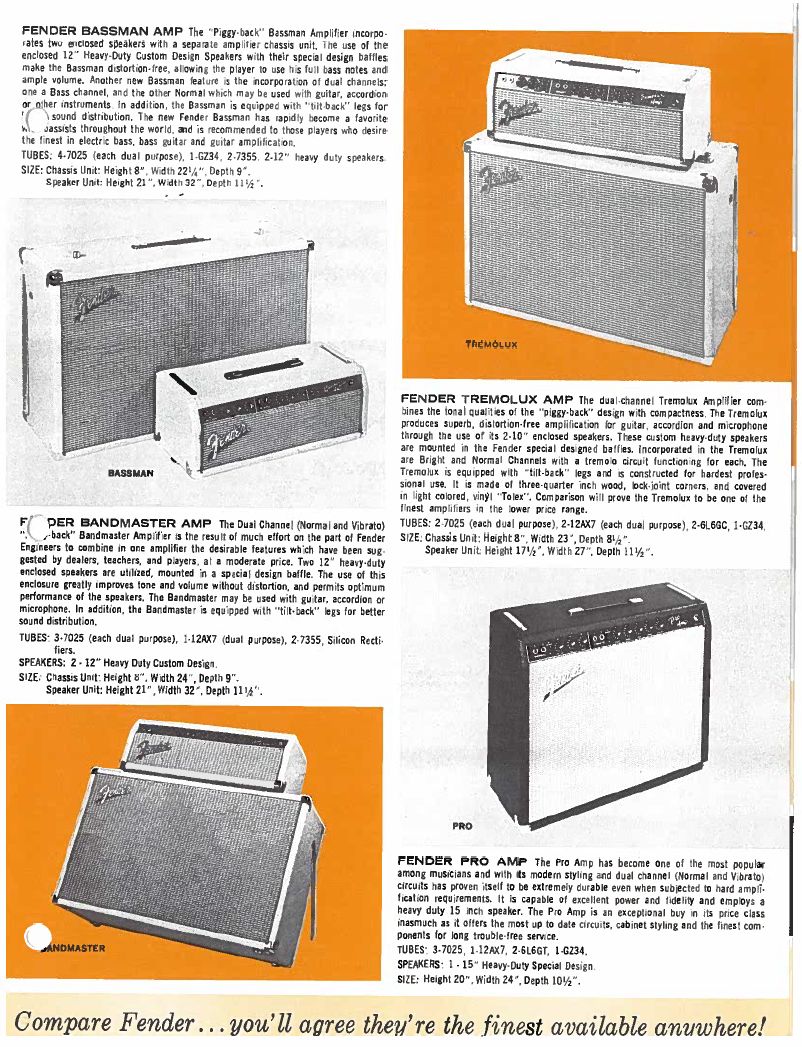
For more info on the AB763 circuit see How the AB763 Deluxe Reverb Works, Build an AB763 and AB763 Modifications.
By Rob Robinette
References
RCA Corporation, RCA Receiving Tube Manual, RC30.
Merlin Blencowe, Designing Tube Preamps for Guitar and Bass, 2nd Edition.
Merlin Blencowe, Designing High-Fidelity Tube Preamps
Morgan Jones, Valve Amplifiers, 4th Edition.
Richard Kuehnel, Circuit Analysis of a Legendary Tube Amplifier: The Fender Bassman 5F6-A, 3rd Edition.
Richard Kuehnel, Vacuum Tube Circuit Design: Guitar Amplifier Preamps, 2nd Edition.
Richard Kuehnel, Vacuum Tube Circuit Design: Guitar Amplifier Power Amps
Robert C. Megantz, Design and Construction of Tube Guitar Amplifiers
Neumann & Irving, Guitar Amplifier Overdrive, A Visual Tour It's fairly technical but it's the only book written specifically about guitar amplifier overdrive. It includes many graphs to help make the material easier to understand.
T.E. Rutt, Vacuum Tube Triode Nonlinearity as Part of The Electric Guitar Sound
[ How the 5E3 Deluxe Works ] [ Deluxe Models ] [ Amp Troubleshooting ] [ My 5E3 Build ] [ Spice Analysis ] [ The Trainwreck Pages ] [ Fender Input Jacks ] [ B9A Prototype Boards ]

